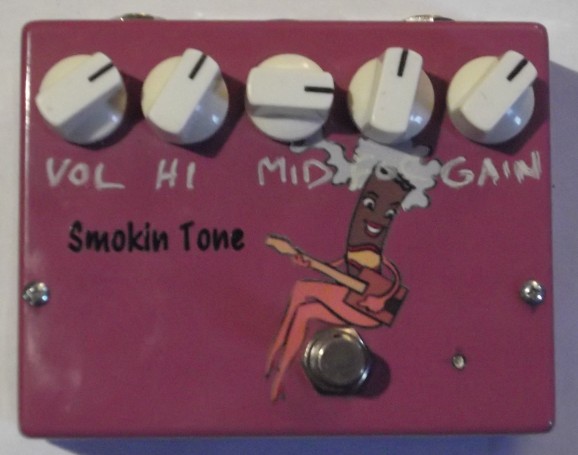
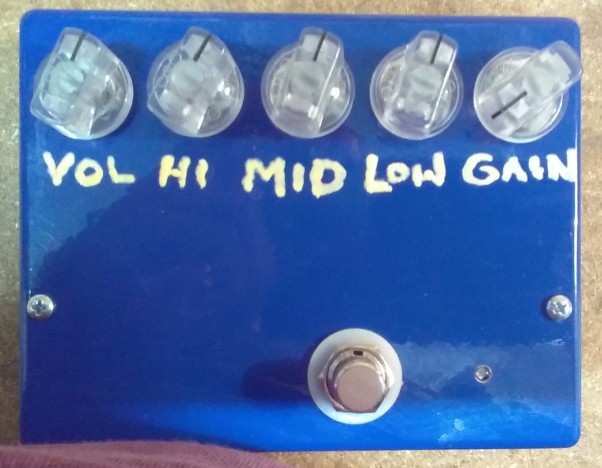
All trademarks mentioned here are the property of their
respective owners.
Here's my Amp Mods document (PDF
6.9M), it details a bunch of guitar amp mods and rebuilds I did,
mostly from the '90's while working for Shiloh Music but some a
little more recent. Back then it was economical to get a
silverface Fender from a pawn shop for cheap (didn't matter much
if it was broken) and gut some or all of it and create a new amp,
typically with an overdrive channel and an effects loop. 3/12/22 -
Updated with a "new" Bassman mod that recently came into the shop
for maintenance, also slightly edited a few things for clarity and
fixed a gruesome overlapping image glitch caused by loss of image
attributes after doing an edit elsewhere (note to self always
check everything after every edit no matter how minor).
Here's a page about using JFETs, a
transistor type that comes close to working like a tube.
Here's an Electronics Calculations program
I made using Free Pascal (last mod 1/18/21)
Here's my Find
Closest Resistor Value program I made with QBasic/FreeBASIC
(last mod 5/14/25)
Content on this page:
All information here is provided as-is and without warranty, use
at your own risk. Tube amplifiers use lethal voltages, do not
attempt to build these circuits unless experienced in high voltage
safety procedures and are familiar with building tube amplifiers.
These are not construction plans, many details are omitted. Rather
these are ideas to inspire and to document some of the things I
make.
Update 5/14/25 - Good things often come to an end - I'm no longer
working at Superior Music, Chuck is moving his music store to
Michigan and although he invited my to tag along that won't work
for me (day job and not into massive amounts of snow). I'm still
doing limited repairs for myself and friends but for the most part
out of the amp repair business. It was getting harder and harder
anyway, they don't make stuff like they used to and walk-in
customers often didn't understand why I couldn't work on their
stuff. Pretty bad when a 60 year old amp is no problem at all but
can't get parts or service info for a 10 year old amp. Solid state
amps got to be a huge problem as the was-common through-hole
transistors and chips became unobtainium (or counterfeit).
For the Smokin Tone and Purple Cow pedals Chuck is looking for a
manufacturer for them and if/when that can be arranged will be
selling them through his new Superior Music store. Alternatively
if we can at least get the cases drilled I can make more of them,
but (especially now) I have no desire to have bits of aluminum
everywhere. This is pretty much why I only made a few. However
I've always been open about my circuits, if you just want one for
yourself and know about electronics the basic circuitry for both
of these pedals is on my JFET page. If you are interested in
manufacturing them get in touch with me or Chuck.
Something coming up - I have a "Deluxe 5E3" kit on order. All my
amps are "fuzzy" (lol) and sometimes I need a small basic clean
tube amp for jams and stuff. The mods I'm thinking about making to
it are putting series diodes on the rectifier tube to keep it from
sparking when the standby is engaged, putting a pre-phase-inverter
master volume in the hole for the extension speaker jack..
sometimes even 15 watts is too much. [6/3/25 the kit has arrived]
12/13/17 - This is a JFET-based overdrive preamp that can be
dialed from almost clean to heavy distortion. The design has three
gain stages with a compensated gain control between the first two
stages (at low gain it boosts the highs, at high gain it cuts the
lows), a fixed high boost between the last two stages, and tones
after that - inspired by my amp mods and not coincidently it
sounds a lot like a high-gain tube amp. The stock design has a
true bypass switch but can be wired to leave the unity-gain output
buffer in place even when bypassed. Very low current drain, less
than 2ma and most of that's for the LED.
Here's an early one in light purple (can't get that case anymore)
and later ones in blue and dark purple cases...


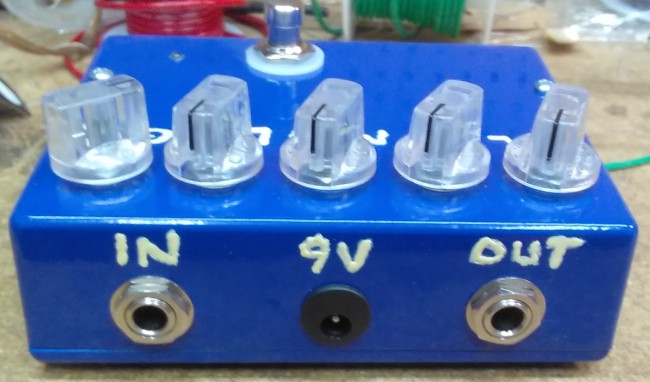

A view of the insides...
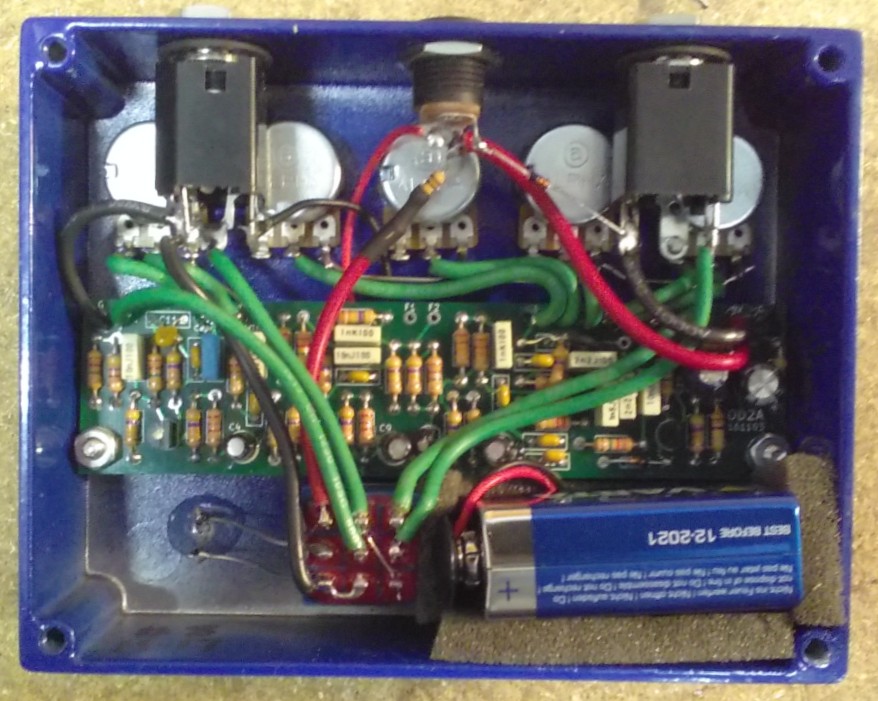
Eventually I'd like to get someone else to make the cases
pre-drilled with professional silkscreening but for now just
making them myself as needed and labeling as requested or however
I feel like. Order from the SmokinTone
page, $179+tax. Customizations are available, including case
color and doodling, more or less gain, optimizing for bass (more
lows, more output, less gain) and always-buffered output.
6/3/25 - As noted above in the page notes, Superior Music has
moved back to Michigan so not sure when I can make more of these,
but if I do I will do it through Chuck. Plus he's got the rest of
the pedal parts. Here's the schematic for the original
prototype (the 470K in parallel with 1000p was replaced with a 1MA
"focus" control), this simulation is closer to the production
version. More about this circuit is on my FETs page.
The Smokin
Tone "Professional Octal Tube Amplifier" Head
12/13/17 - Recently I built a compact tube amp head for Chuck
Kotlarus...
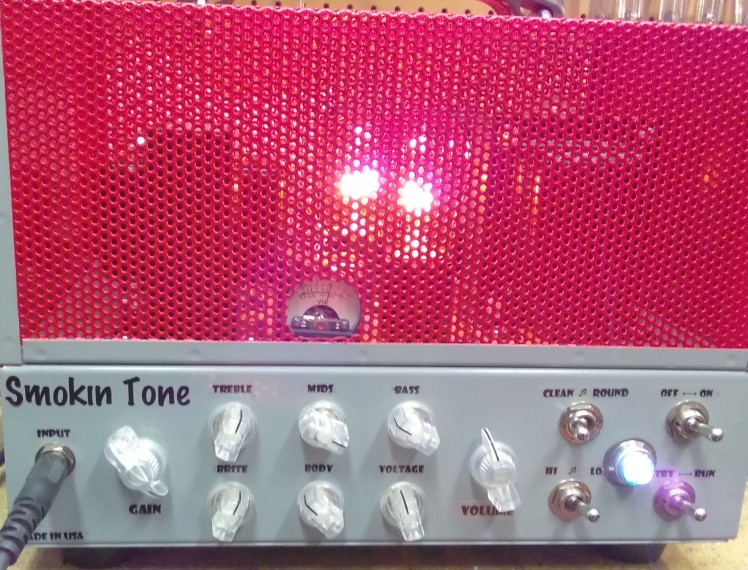
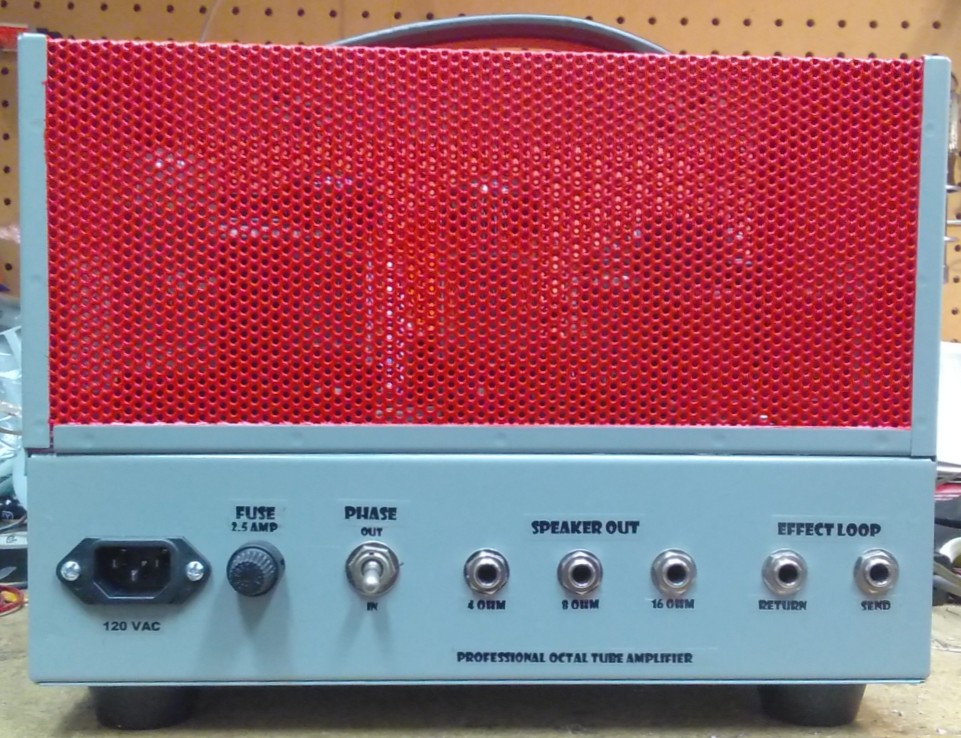
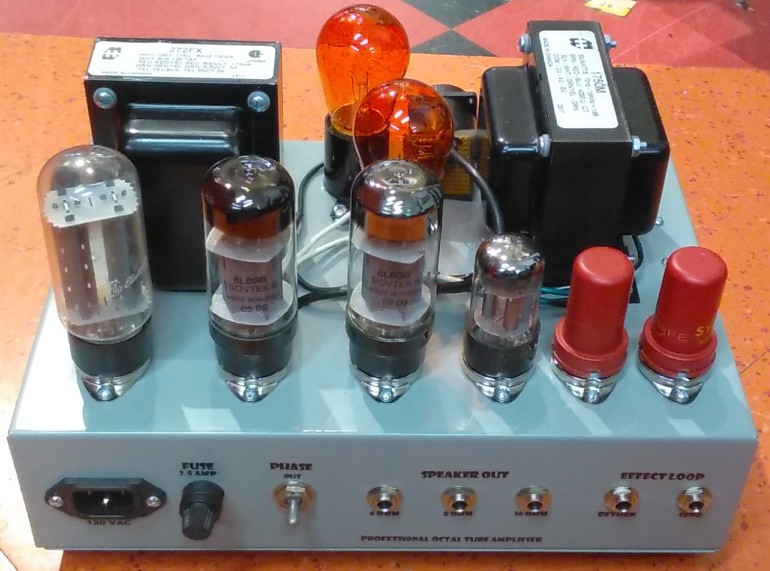

Specs for this particular amp...
A cool thing about this amp is the low power switch that inserts
two 11 watt bulbs in series with the output transformer center
tap.. the bulbs pulse with the signal and because it's a class-A
amp, they dim when it goes into clipping. I've seen a lot of
schemes for reducing output power (usually done by switching to
triode wiring or varying the screen voltage) but never tried the
obvious - just put a resistor in series with the output
transformer feed. That worked but a resistor there gets very hot,
so used light bulbs instead.
Scope shots for normal, round and low power settings...
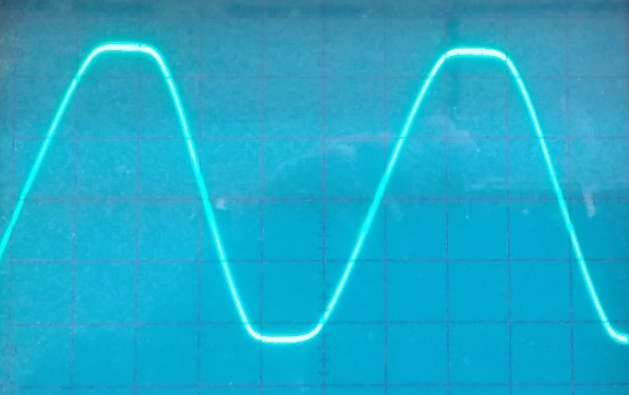
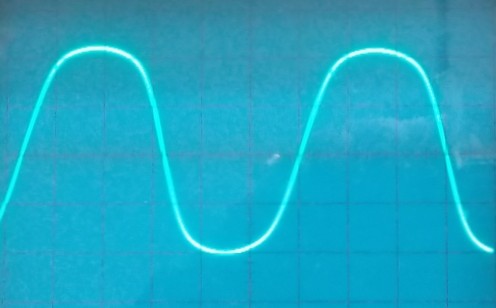
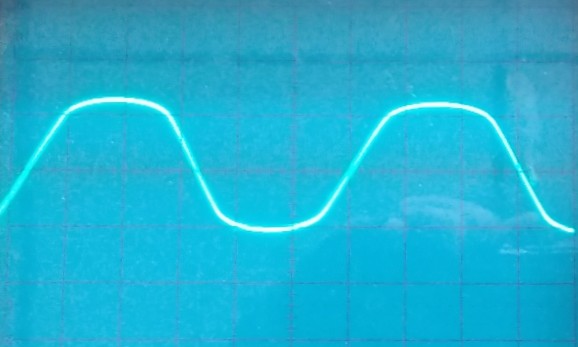
Overdrive with different gain and voltage settings...
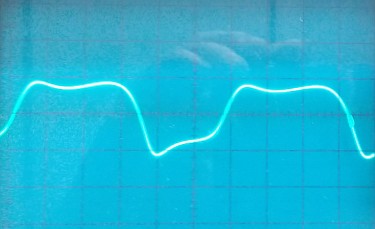
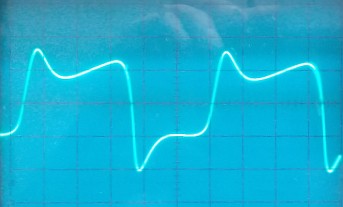
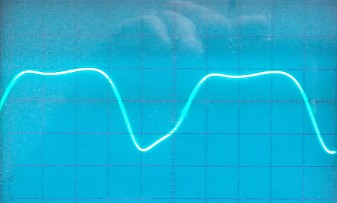
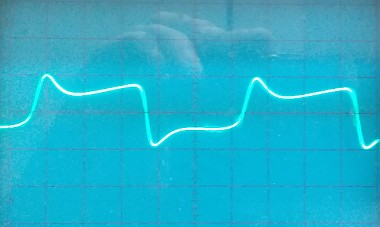
Cool stuff!
Planning on making another one just like this one and maybe some
other variations, I love the chassis. Possibilities include using
common 12AX7 preamp tubes (6SJ7's are rare and often noisy), gain
or channel switching, and a class AB configuration for 40 to 50
watts output power. It's very hard to predict what another
musician will want in an amp - some like two or three knobs, some
want independent channels and output power needs vary widely. At
Skully's Saloon where I play and run sound even a 15 watt amp can
be too loud, but a downtown country gig might need 100 watts of
clean. For what I do a simple gain switching scheme where it just
boosts the preamp gain and drops the output level works for me.
Others need full channel switching or no switching at all because
they use pedals for that. So for now treating it like an amp
mod... customer tells me what they want then I make it.
6/5/20 - Here's the original schematic of the Pro Octal Amp...
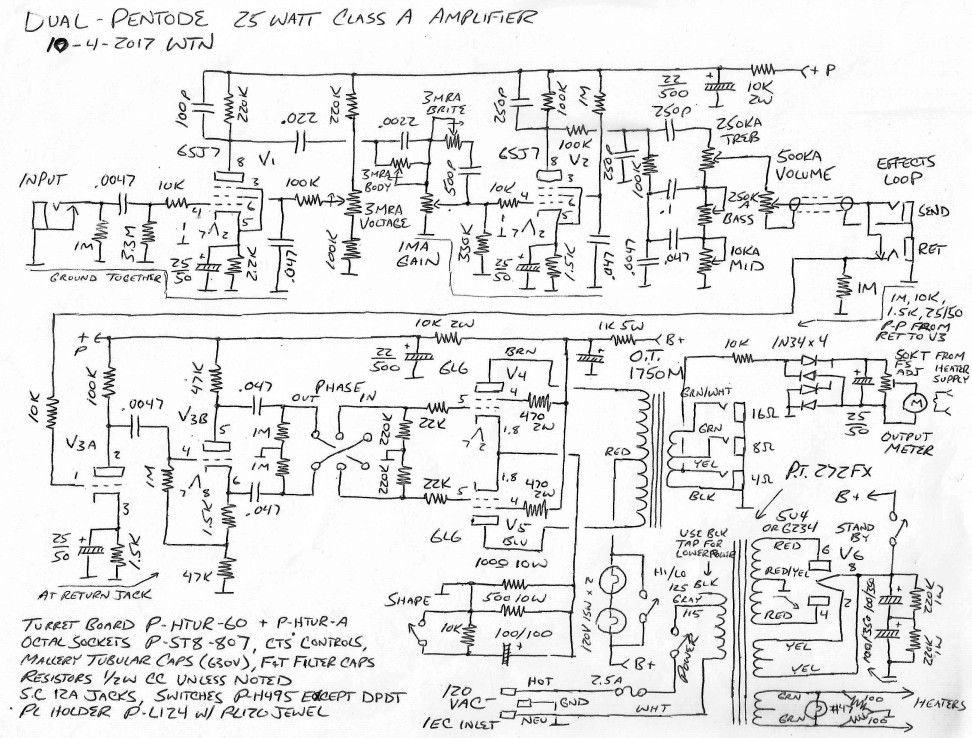
This shows the voltage control connected to the 1st stage but
ended up moving it on the 2nd stage instead where it can better
alter the tone. Originally wanted to use it to set the first stage
gain but the operating point shift had too much impact on input
overload. There is no negative feedback in the power amplifier
section, making it possible to flip the phase by reversing the
power tube grids. Other than using old octal pentode preamp tubes,
there's nothing that special about the preamp design other than
the compensated gain I usually use - this time with variable low
and high pre-clip equalization. The post-clip tones are
traditional with an extra cap on the mid so that it doesn't also
boost highs as much. The real coolness is using light bulbs in
series with the output transformer supply feed for the low power
function. Surely someone has thought of it but haven't ever seen
an amp that does this. At first I used resistors but to achive a
useful power reduction they had to be in the 1K range and got
quite hot, so replaced the resistors with light bulbs. This is a
class-A amp so the full power and zero power current is similar
(in this amp full power current is actually a bit less) so there
isn't a whole lot of dynamic effect, would be interesting to try
this trick with a grid-biased class-AB amp.
Stromberg
Signet 22 (SAU-22) Mod
This is a cool little amp from around 1960, puts out about 20
watts with a pair of EL84's, a 6U8/7687 pentode/triode gain
stage/phase inverter and a 12AX7 preamp tube. They're fairly
common and make a nice mod amp, so far I've done three of them
(two for Chuck, another for a customer who had one and heard the
first one I did for Chuck). The original amp is a simple PA
amplifier with two screw-on type mic inputs, a RCA ceramic
phonograph input, four knobs for the inputs and tone, and
terminal-strip speaker connections. Before even bothering with
doing too much I change out the filter and coupling capacitors
which are usually toast and make sure the basic bones of the amp
are good.
Here are some pics I made of the original rough mod schematic and
mods 2 and 3...
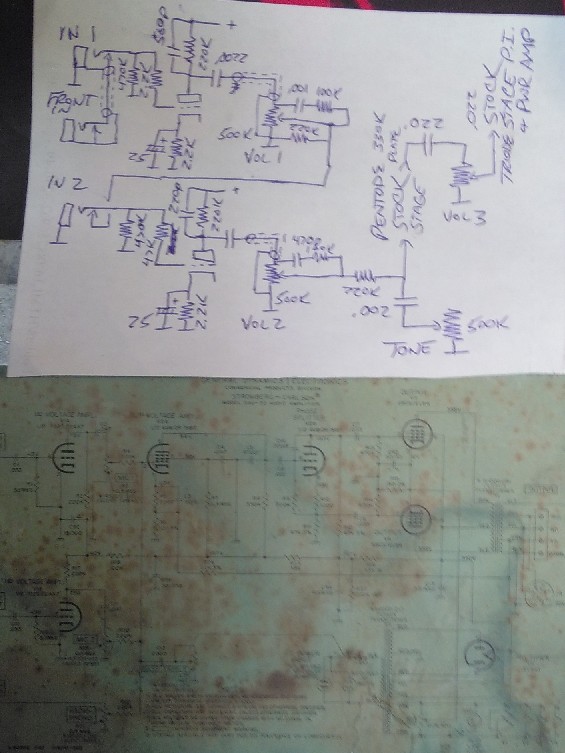
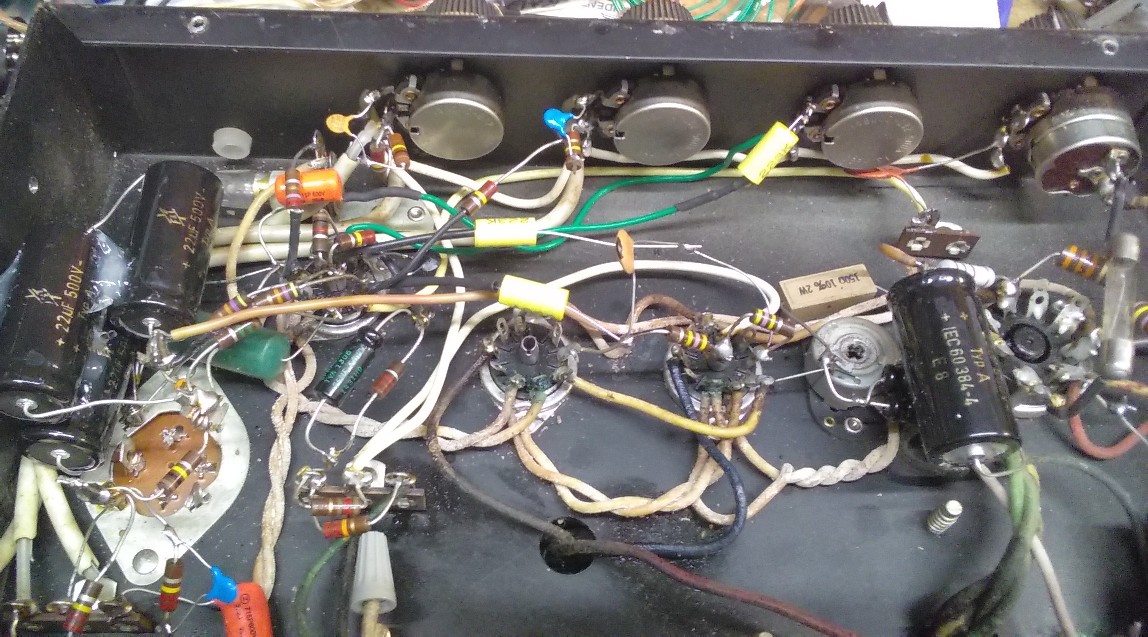
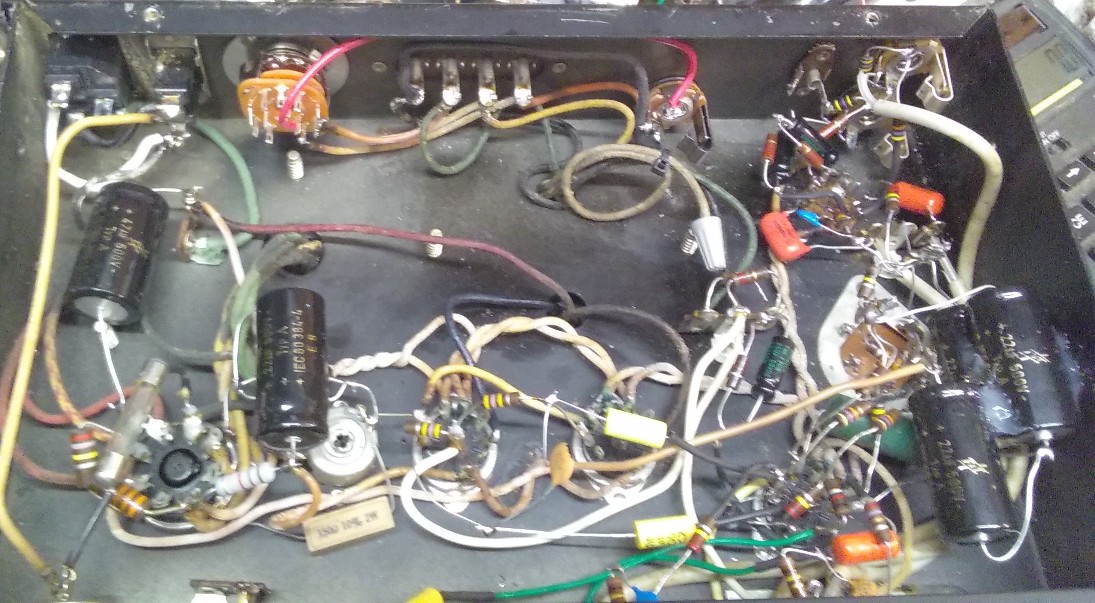
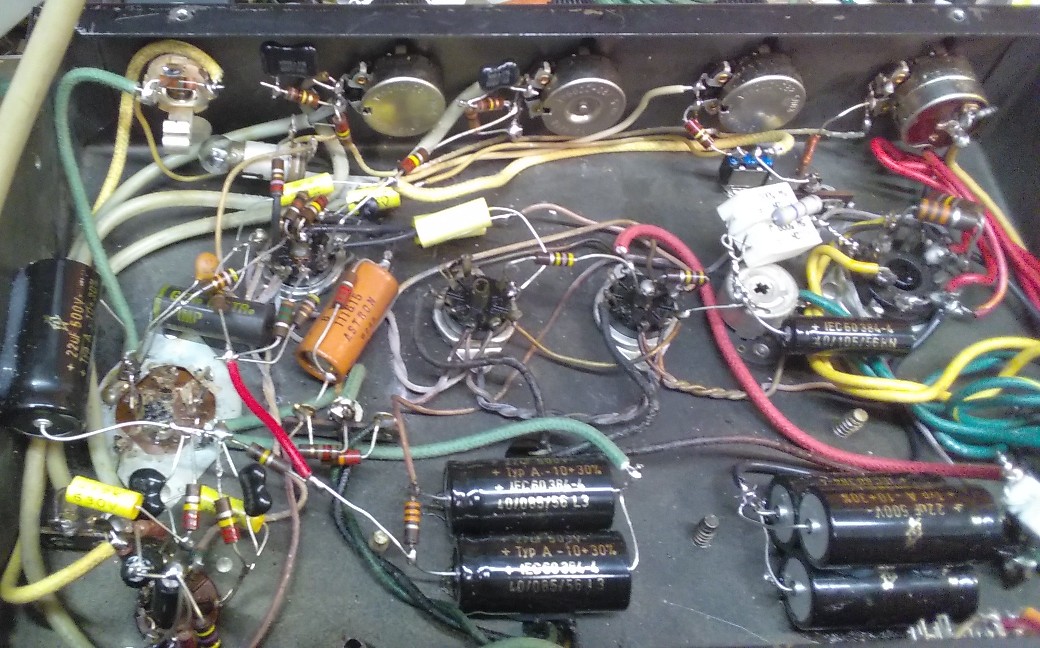
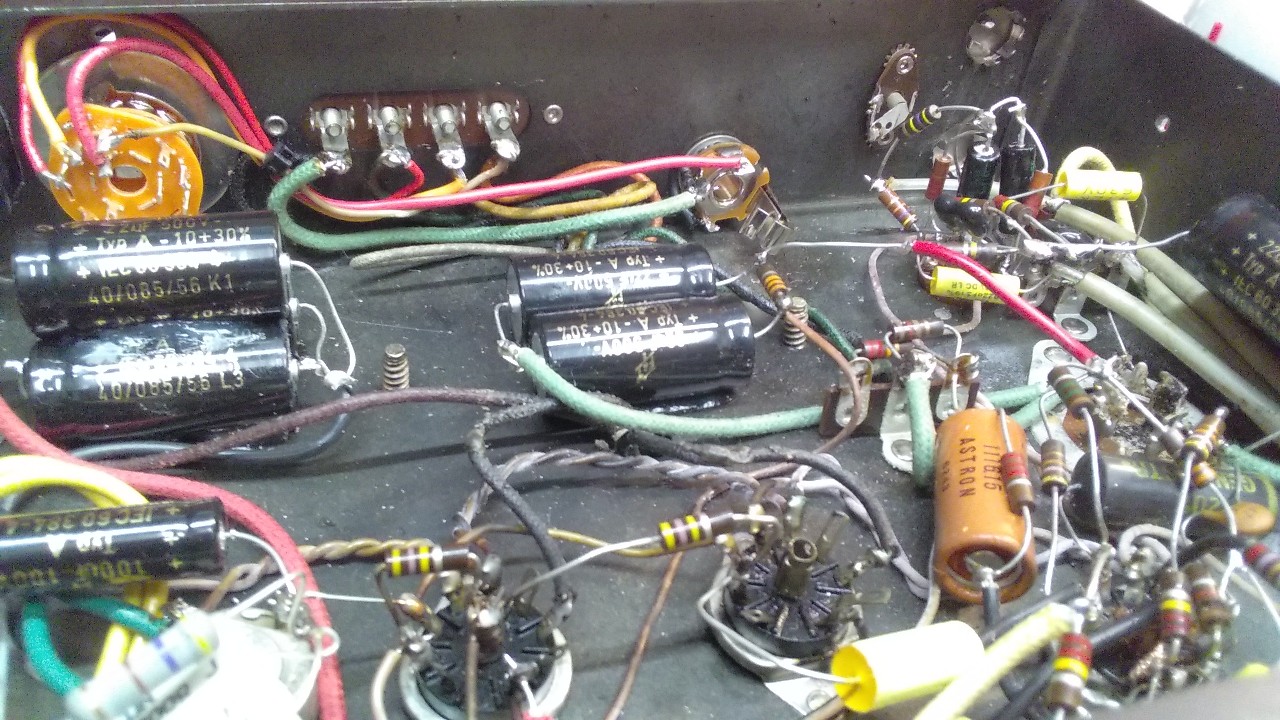
Neither mod matches the original schematic - every amp is
different and has different needs. Mod 2 on the top apparently has
no plate cap at all on the 2nd stage, and an extra cap on the
phase inverter output at the power tube grids. Also has no front
input jack. Mod 3 looks like it has a cap on the pentode plate
resistor, and also has a toggle switch to select whether the tone
control is after gain 2 or after the master. Also left in the
original pentode stage bypass capacitor. Basically when I do mods
I play guitar through it and experiment with various filter values
until I'm happy with the tone. On both these mods added an extra
filter stage for the EL84 screen grids (470 ohms plus 22uF), on
the original they were connected directly to the main output
transformer supply.. yuck. The extra resistance limits the screen
grid current to keep the tubes happy and lowers the hum level.
6/5/20 - A better schematic of the first two versions of this
mod...
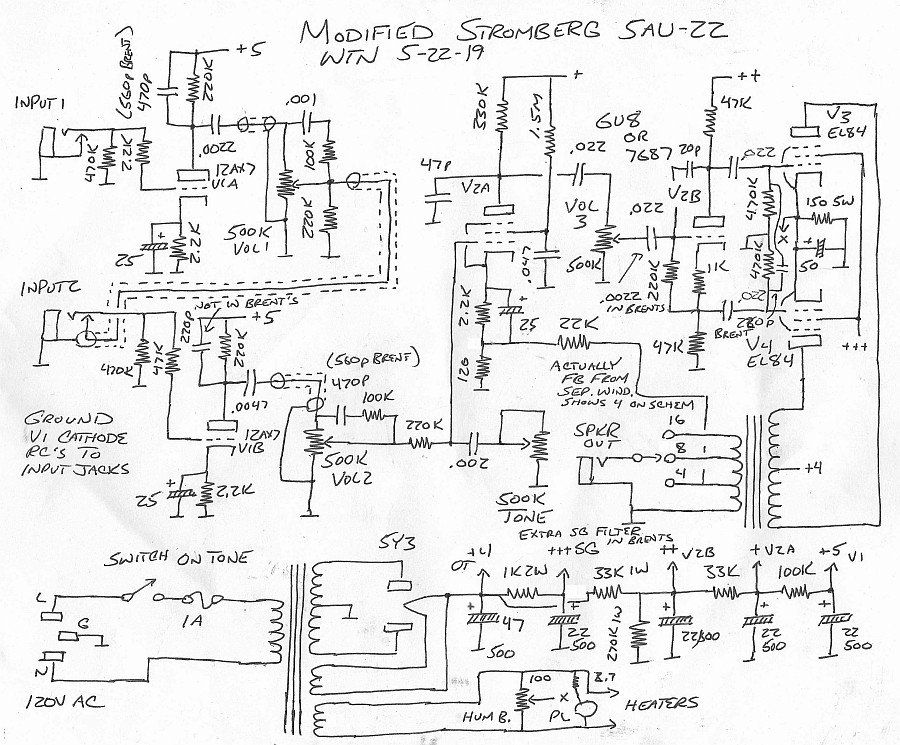
The tone position switch on the 3rd mod adds a 220K after the
wiper of volume 3, then switches between the resistor after volume
2 and the resistor after volume 3. The preamp resembles my 3-stage
overdrive design but using a pentode rather than a triode for the
3rd stage adds a lot more gain - it needs the extra gain control
to tame it down and be able to get clean tones. Having the preamp
clip stage in the power amp feedback loop has the effect of
lowering the gain as the master volume is increased.
Modified Vibrochamp with a Solid State
Phase Inverter
This has got to be one of the funniest things I've done to a tube
amp but it came out surprisingly well. Customer had a blackface
Vibrochamp and wanted it to be louder to take on the road... on a
good day a stock Champ output is maybe 4-5 watts into 4 ohms
(stock was 3.2 ohms) and it had an 8 ohm speaker in it so it was
maybe pushing 3 watts. Well sure, could go even 50 watts with
Bassman transformers but the replacement speaker had a huge magnet
on it, no way 6L6's will clear that so had to be something with
6V6's. At first was thinking Deluxe-like but before doing that and
ordering transformers and cutting holes and stuff in a vintage amp
thought I would try to see what I could do with the stock power
transformer and something more minimal and reversible. First
thought was to use the existing 6V6 to drive a 2nd 6V6 for push
pull but testing that idea in LTspice showed it to be flawed.
Simple idea but the 2nd tube will always be an inverse of the
first tube (once the gain is balanced) so no way to get class AB,
at best just doubles the output with the same (ugly weak)
single-ended distortion. Adding a proper Princeton-style phase
inverter fixed it in simulation, able to get about 15 watts clean,
but as I was already putting another 6V6 on the heater line wasn't
keen on adding another 12AX7 to the heater winding, plus the whole
punching a hole in a vintage amp thing. So thought just use a
transistor phase inverter. Which would have been awesome if I had
a 500V 1W+ high gain transistor hanging around. Got 160V 600mW
2N5551's though, maybe I could stack 3 together? Why yes I can!
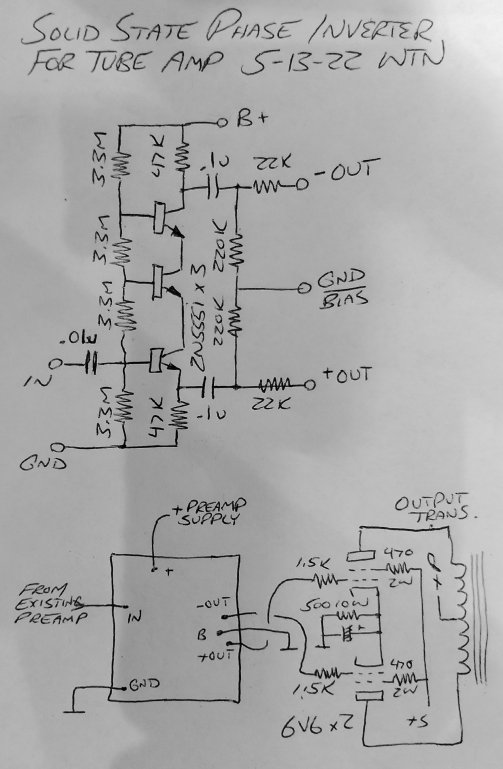
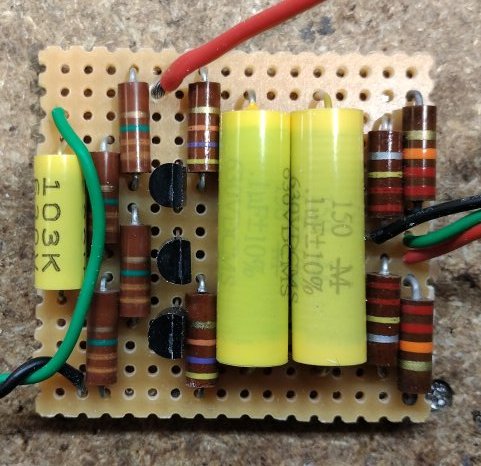
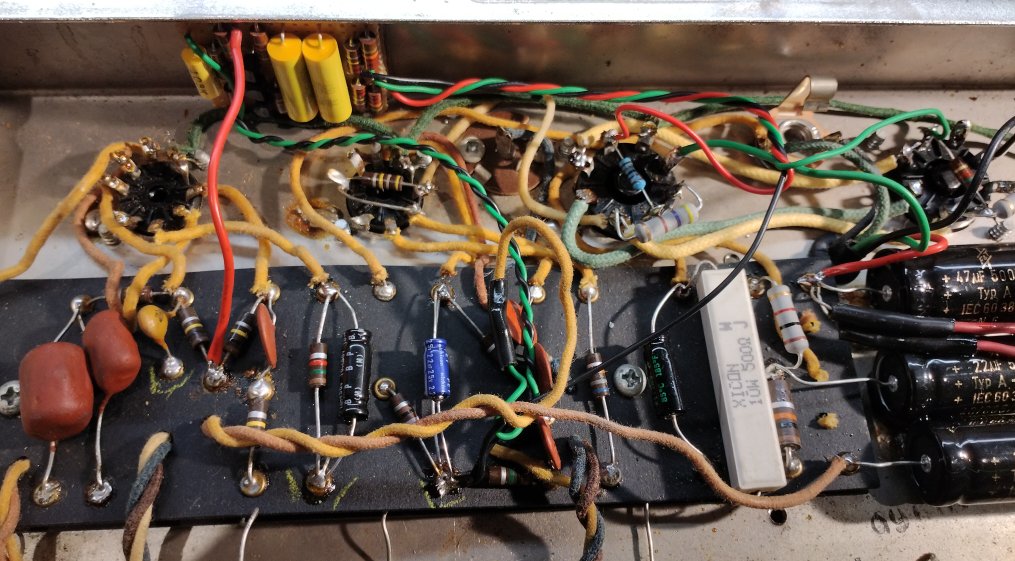
The resistor values could probably be optimized further but these
were the components I had on hand and seem to work well. Using a
solid state rectifier (a pair of 1KV 1.5A diodes) and an output
transformer I had laying around was able to get about 12 watts
into 8 ohms and about 15 watts into 16 ohms, roughly equivalent to
a Princeton. Didn't touch the preamp section, it had already had
the negative feedback disconnected.
The following simulations show more about what's going on with
varying levels of drive (click for bigger images)...

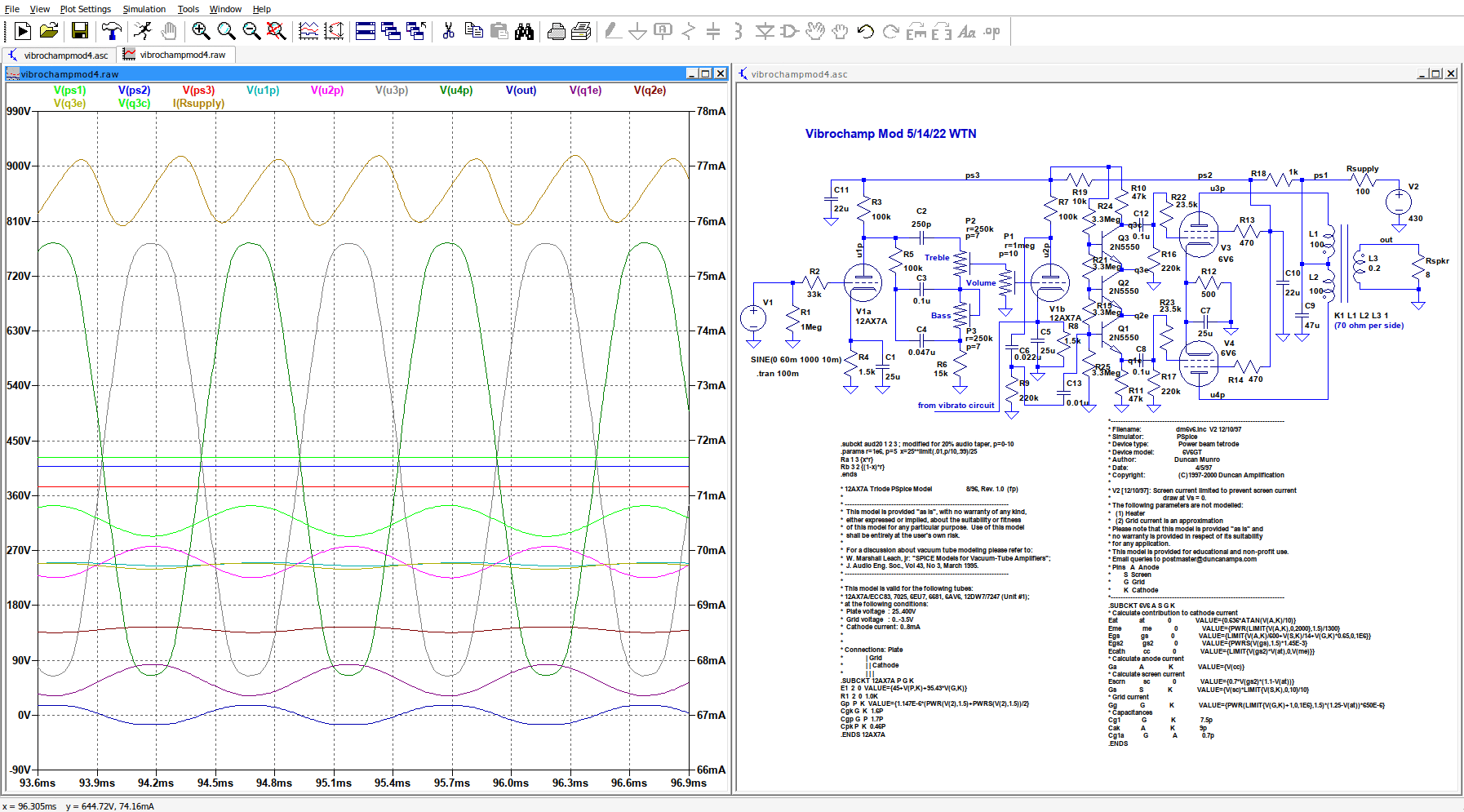
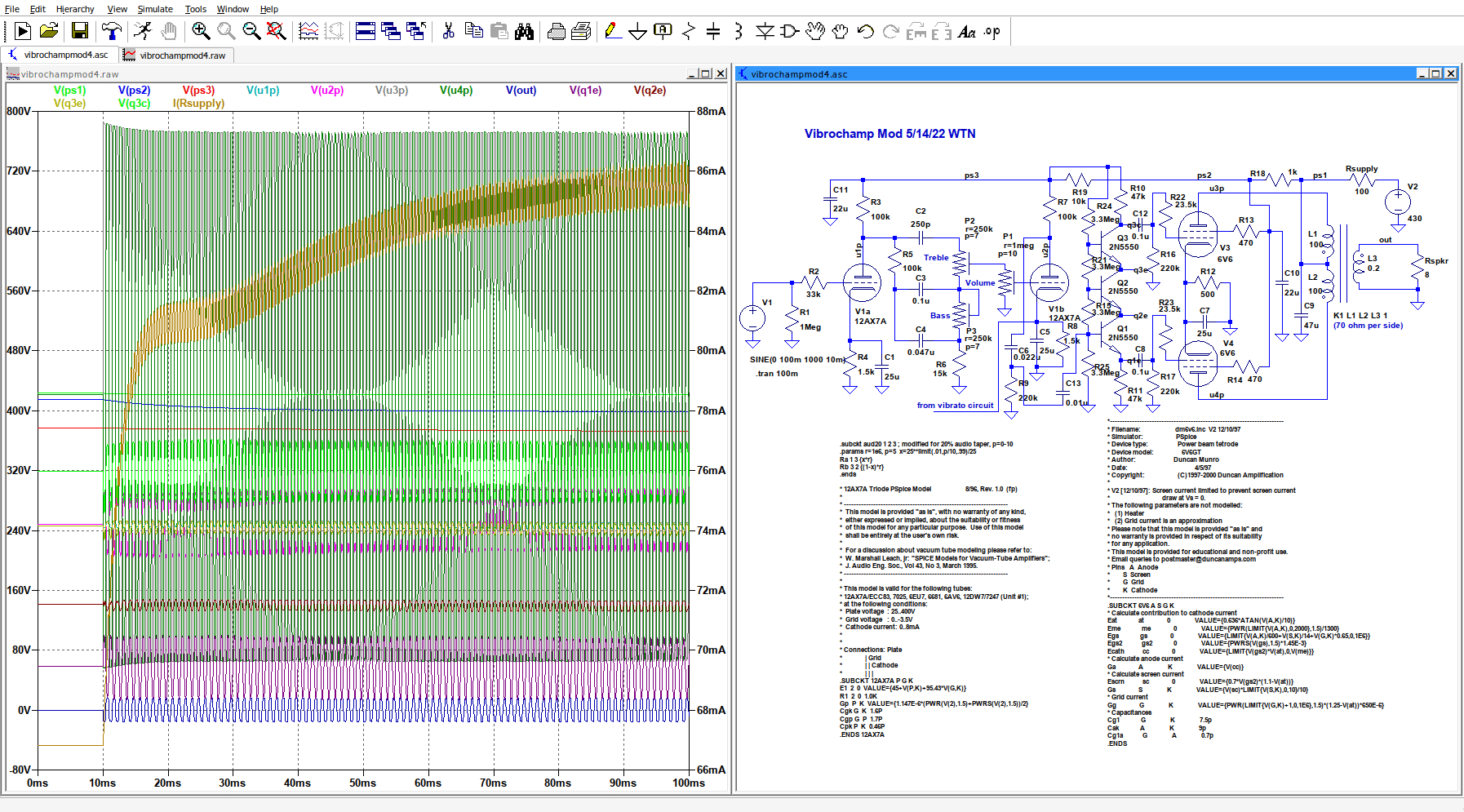
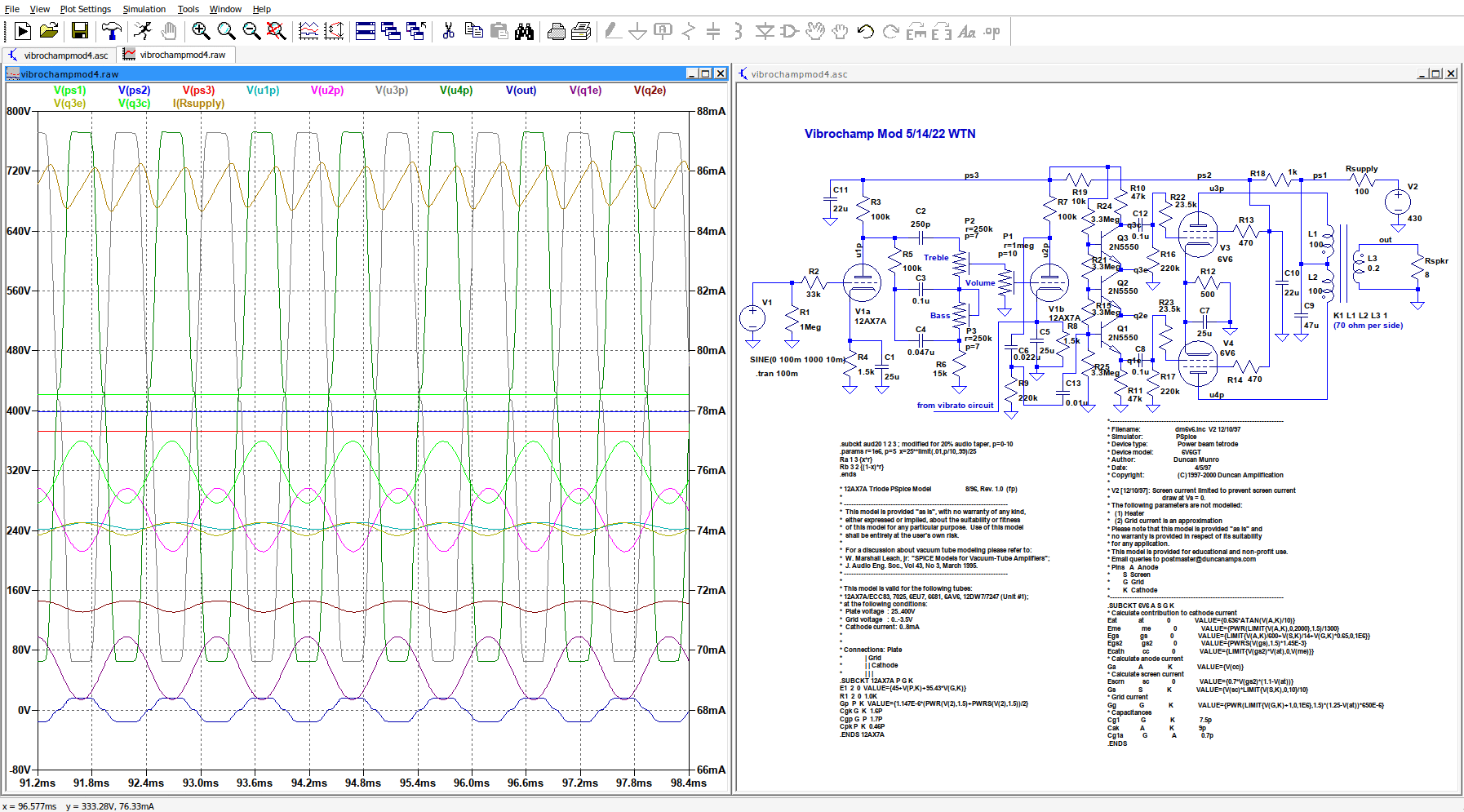


The floating emitter/collector notes get a bit "spiky" under
heavy overload, not sure what's up with that but the spikes do not
appear on the phase inverter outputs and with the output tubes in
full saturation it isn't going to be heard anyway. Using the stock
2n5550 LTspice model here but it's the same with another 2N5551
model. Adding 1000pF or 0.01uF capacitors to the floating base
nodes mostly make the spikes go away by clamping the emitters to a
mostly constant voltage, but that actually puts more voltage
stress on the transistors. Letting the emitter and base nodes
float and do whatever they want provides better voltage
distribution, keeping the maximum voltage on each transistor to
under 160 volts even with the spikes (if they are even real).
Every node is current limited so even if there is some breakdown
it's not going to matter much. Here are the LTspice files
if interested, the tube models were found on the web. The idea for
using LTspice's uniform RC-line symbol for a potentiometer came
from "analogspiceman's" tube
amp simulation files, awesome idea that avoids having to add
a symbol file.
An LTspice simulation of an entire tube
amp
This simulation borrows ideas from analogspiceman's tube amp
simulation, the control and tube models are adapted from the
Fender5E7Bndmstr.asc file, the rectifier tube models are from
Duncan Amps, adapted to use a triode symbol to avoid having to
make a new rectifier symbol, so the schematic looks a bit funny.
Most aspects are simulated - power transformer, ripple, filter
capacitors, sag - but the transformers are "perfect" other than
winding series resistance. That's fine by me, in my opinion if one
can hear transformer effects then it's either inadequate or being
overloaded.
Here's the LTspice schematic...
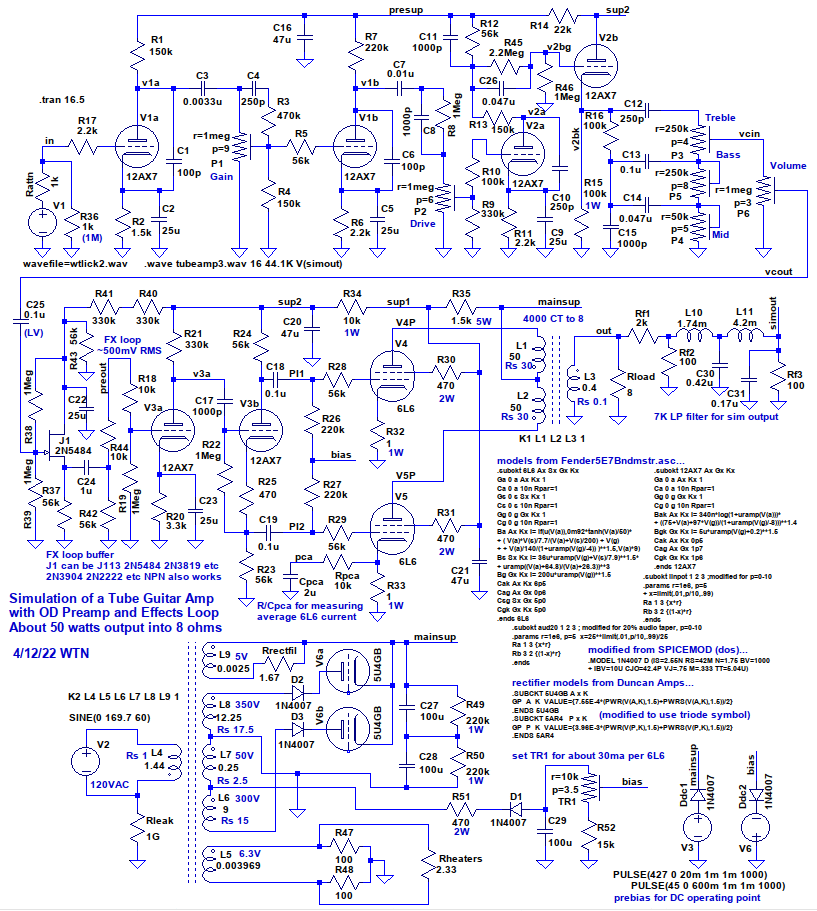
The simulated amplifier uses three 12AX7 tubes, a JFET for
driving the effects loop, two 6L6 tubes, and one 5AR4 or 5U4
rectifier tube. The preamp is a three-stage design with a gain
control between the 1st and 2nd stage and a drive control between
the 2nd and 3rd stage. The gain control has both low and high
frequency compensation, the drive control has low frequency
compensation. The preamp is followed by a cathode follower driving
the tone stack and volume control, which feeds a unity gain
N-channel JFET buffer driving the effects loop send. Choice of
JFET isn't critical, doesn't even have to be a JFET, an NPN
transistor works just as well. The preamp design is typical of the
kind of stuff I make but haven't built this exact design (yet),
usually I just have a single gain control in conjunction with a
clean channel or some other way to drop the overall gain. In this
single-channel non-switching design the additional drive control
provides a simple way to clean it up or go full-on dirt.
The extra circuitry around 3rd stage V2a and cathode follower V2b
is to provide more symmetric 2nd-order filtering - high frequency
filter C10 is connected directly across V2a so its effect is
asymmetrical, R13 and R12 attenuate the signal to drop it to
effects level (after passing through the tones/volume), and C11
provides additional more symmetrical high frequency filtering. R45
and R46 shift the DC down to avoid exceeding the 12AX7's
cathode-heater breakdown voltage, C26 bypasses R45 so that the
full AC signal is applied to the cathode follower.
The power amp (from the effects return) has a 12AX7 gain stage
V3a with a rather large plate resistor for maximum voltage gain
(to reduce the effects loop level), feeding a single stage unity
gain phase spliter which feeds the 6L6 power tubes with fairly
large (56K) grid resistors to avoid too much asymmetric shift when
overloaded. There is no overall negative feedback. Resistor R35
between the OT supply and screen grid supply is moderately high
(1.5K) for a bit of sag compression, can be smaller or a choke for
tighter response. 1 ohm resistors R32 and R33 are for setting the
bias, Rpca and Cpca are only for the simulation, for measuring the
average current through V5. Rload represents the speaker, Rf1,
Rf2, Rf3, L10, L11, C30 and C31 are only for the simulation to
mimic high frequency speaker response, although a basic
compensated line output could have a similar design. Originally I
tried the simulated speaker model from the 5E7 simulation,
although probably more accurate it distorted the output waveform
making it hard to tell how close the output was to a real tube amp
- I'm used to using a pure resistive load when bench-testing
amplifiers. With the resistive load it looks pretty much identical
to what I'm used to seeing on the scope.
The power supply is pretty much like a typical tube rectifier
amplifier - ignore the grid in the 5U4 symbols and both sections
are in one envelope. Rrectfil represents the rectifier tube
filament, Rheaters represent the 12AX7 filaments. D2 and D3 in
series with the rectifier tube plates is a common trick for
keeping the rectifier from sparking/shorting from power surges.
TR1 is the bias control. V3, V6, Ddc1 and Ddc2 are not part of a
real circuit, they are only to briefly pre-bias the simulation for
setting a useful DC operating point so that static node voltages
and component power dissipations will be useful, the initial pulse
voltages are set to be similar to the zero signal supply and bias
voltages. The GigaOhm resistor Rleak is only for the simulation so
that it doesn't complain about a floating node, there should be no
connection between the AC primary and ground. The power switch,
fuse, standby switch and pilot light are omitted from the
simulation schematic. Although the simulation is mostly complete,
it is not intended to be plans for making a real amplifier - do
not attempt to build this unless experienced in these things and
you know how to fill in the missing bits.
Here's are low gain high volume transient simulations with 5U4
and 5AR4 (GZ34) rectifiers... (click images for bigger)
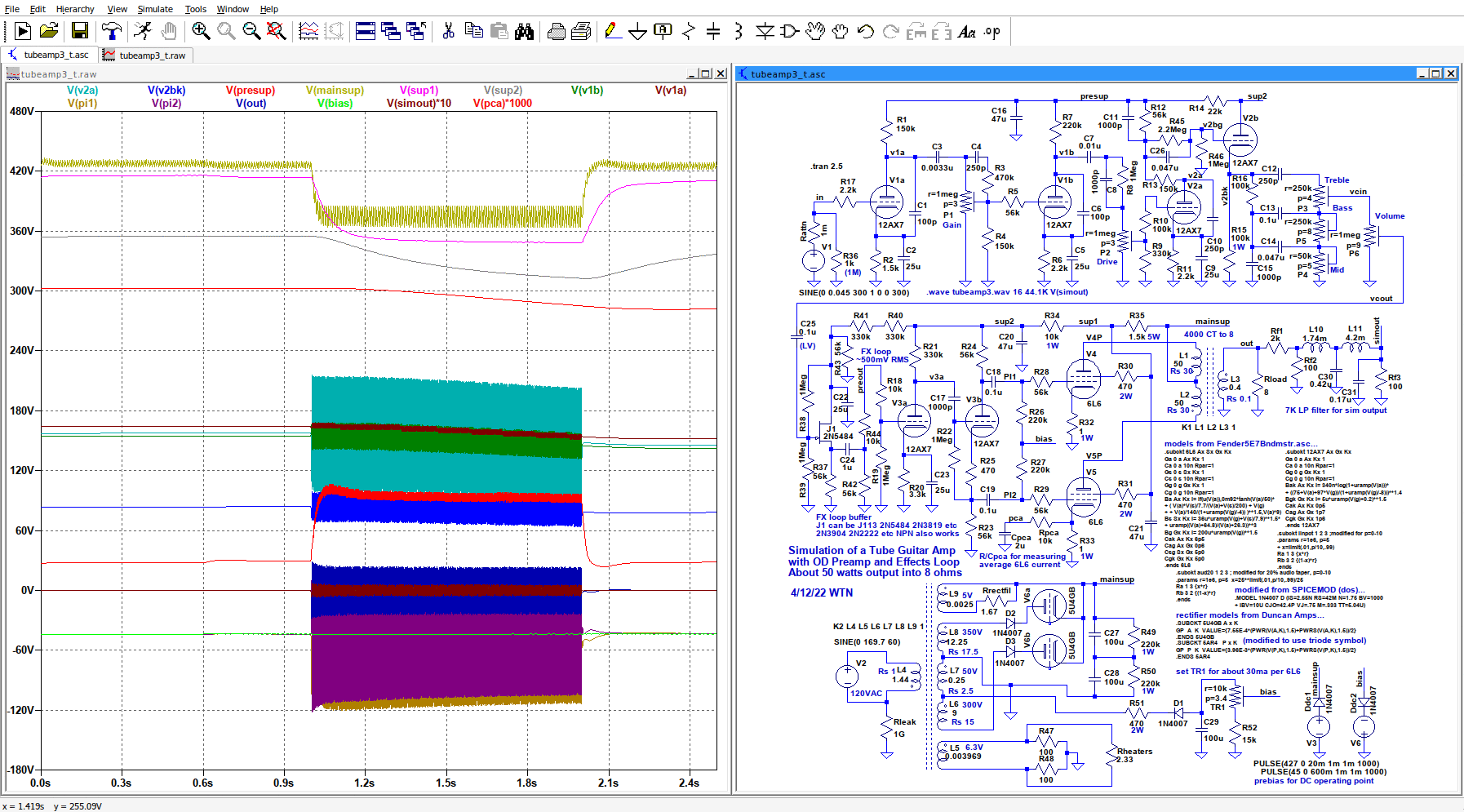
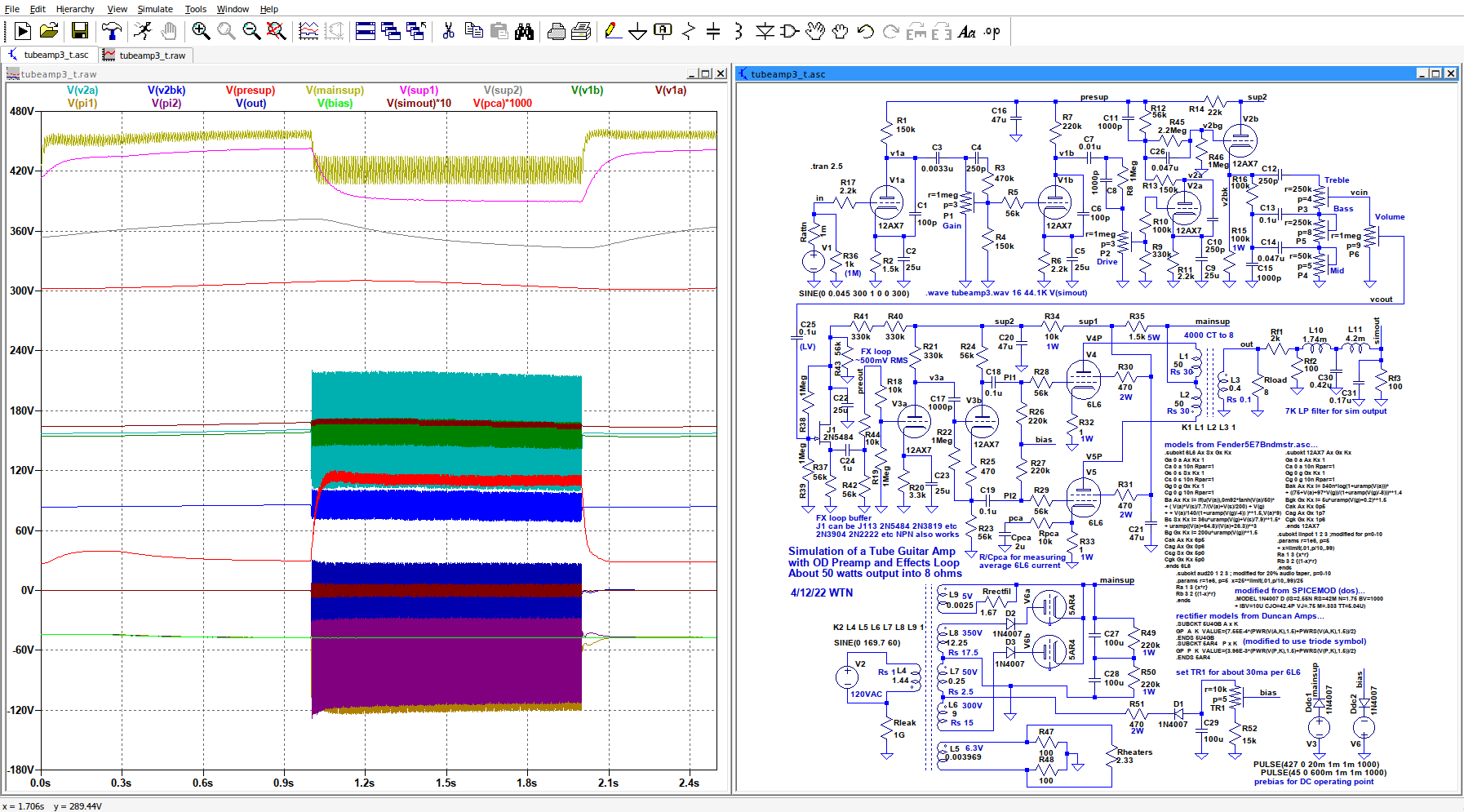
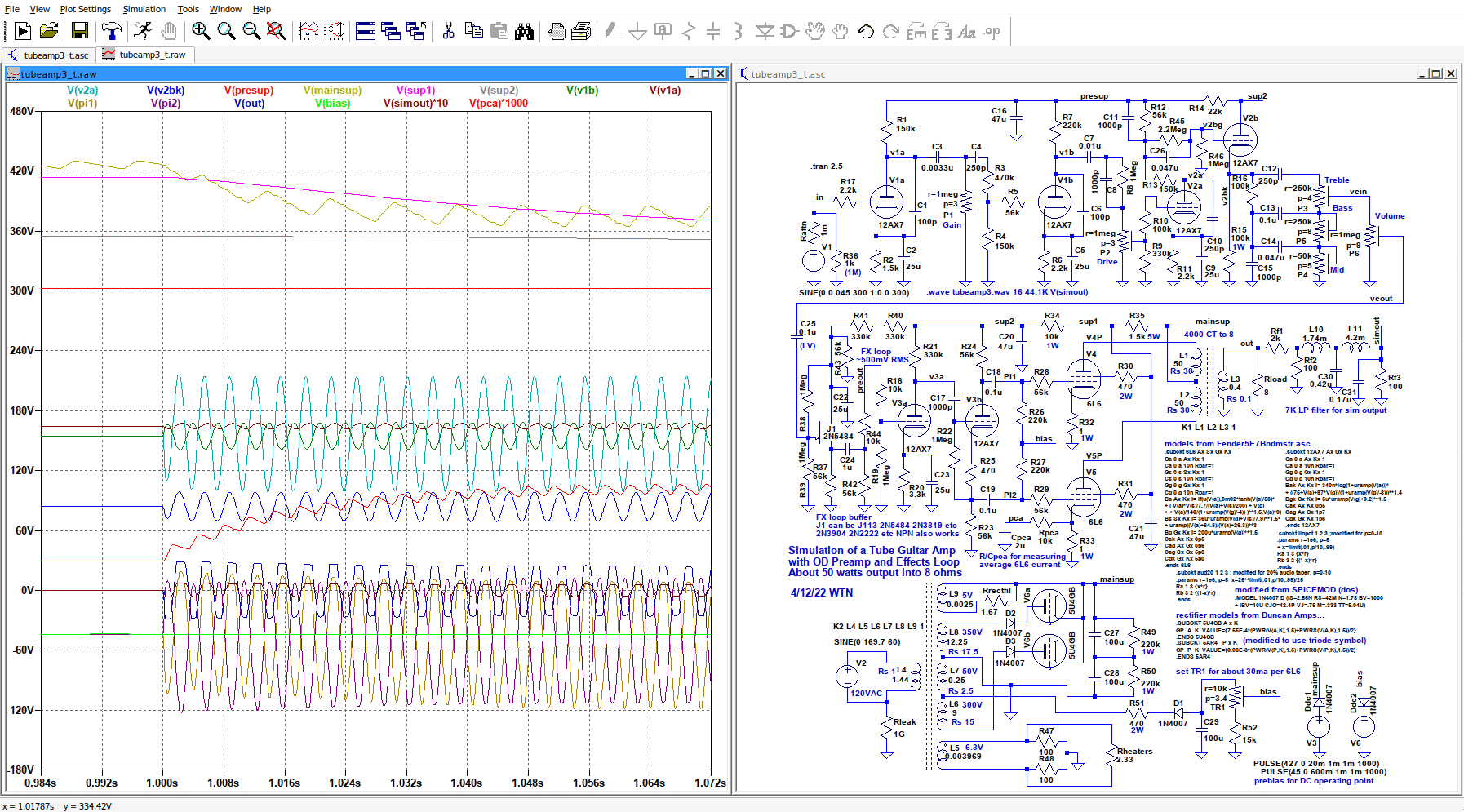
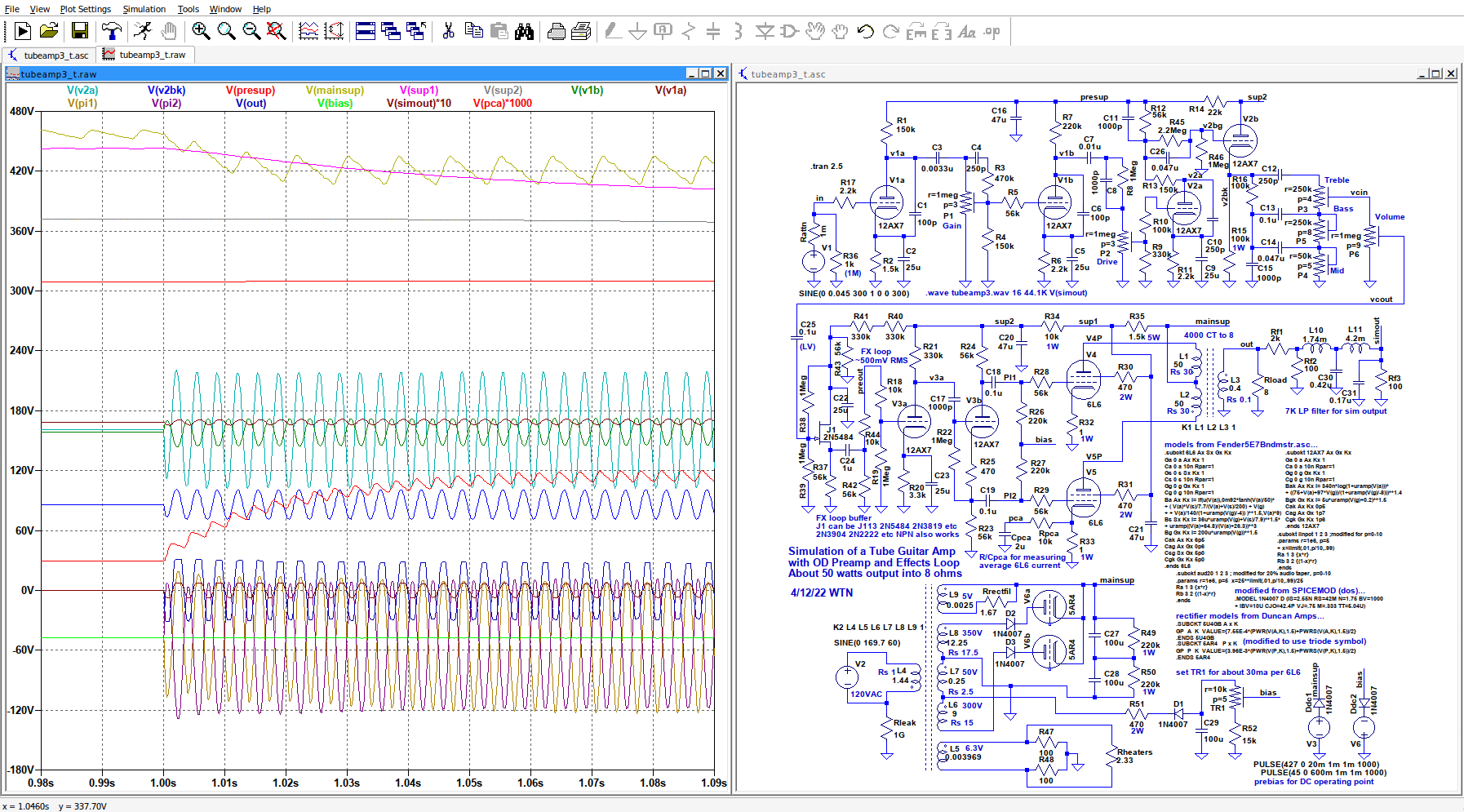
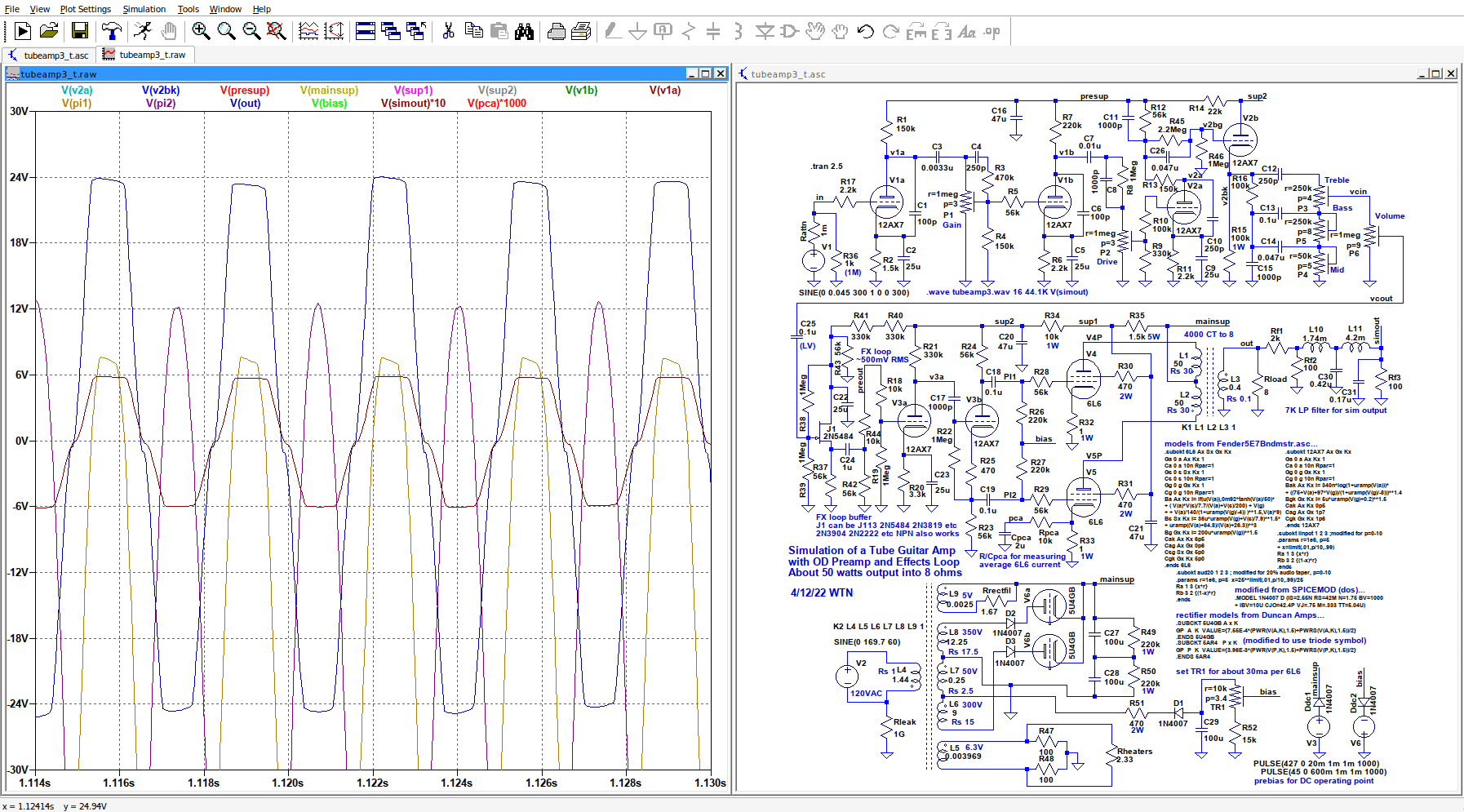
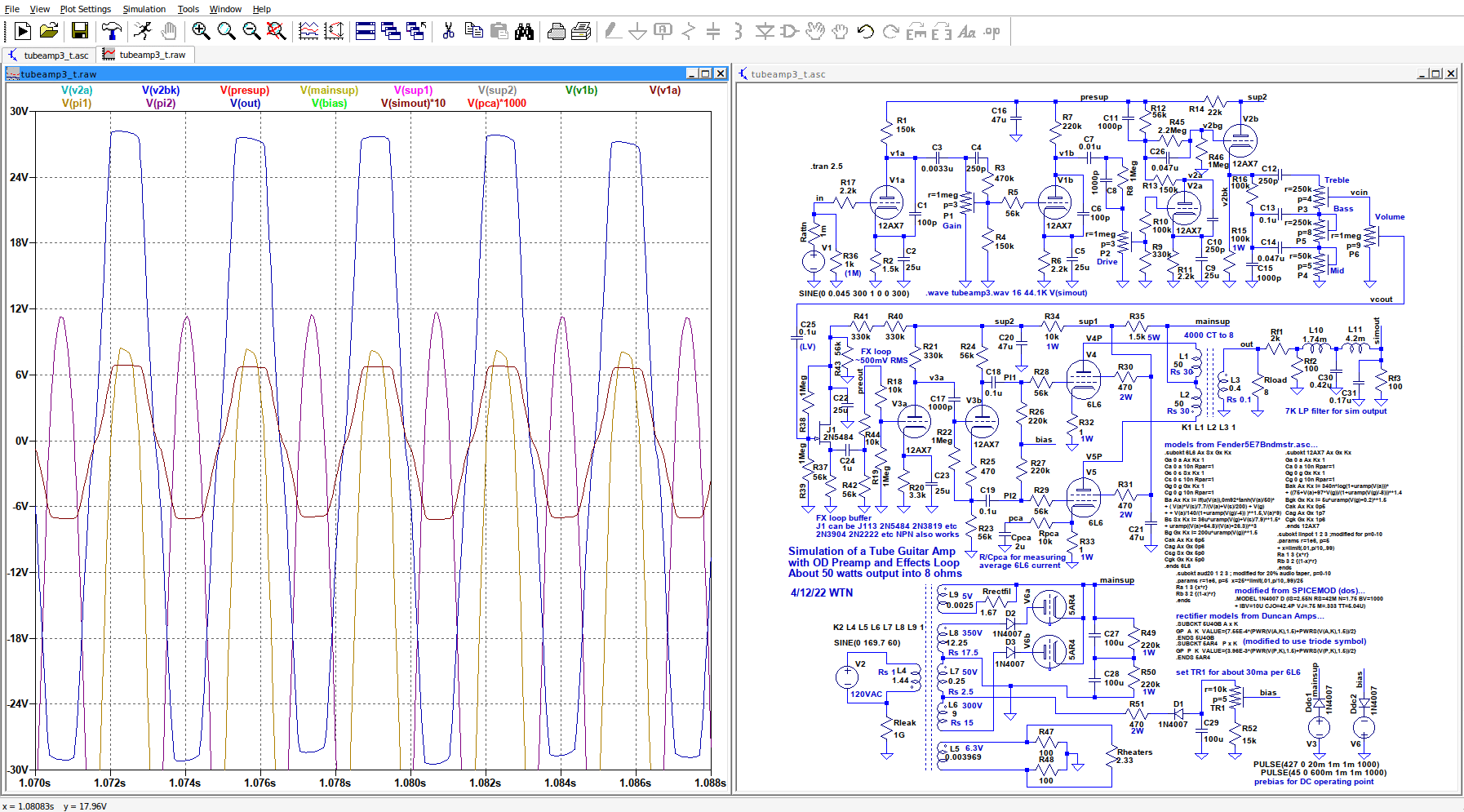
The 5U4 rectifier has lower output and more sag under load,
whereas the 5AR4 delivers more power and a tighter response. In
the simulations the 5U4 is clipping at about 24V peak/17V RMS,
equivalent to about 36 watts into 8 ohms at clip, and the 5AR4 is
clipping at about 28V peak/19.8V RMS, equivalent to about 49 watts
into 8 ohms at clip. Thereabouts.. output power in a real
amplifier is highly affected by the power and output transformer
specs.
Here's how it responds to an actual guitar signal at low gain
(with a 5AR4) and at higher gain (with a 5U4)...
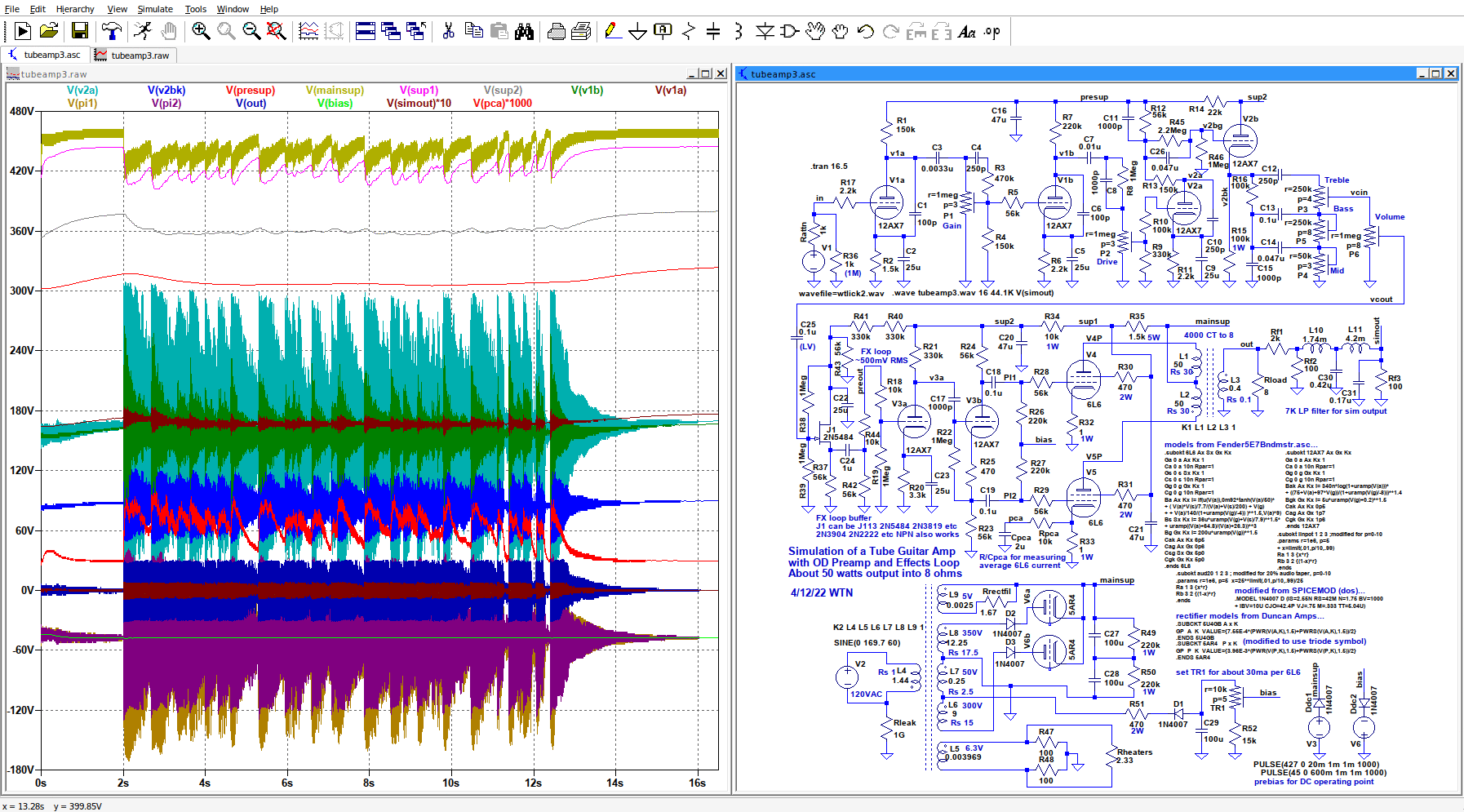
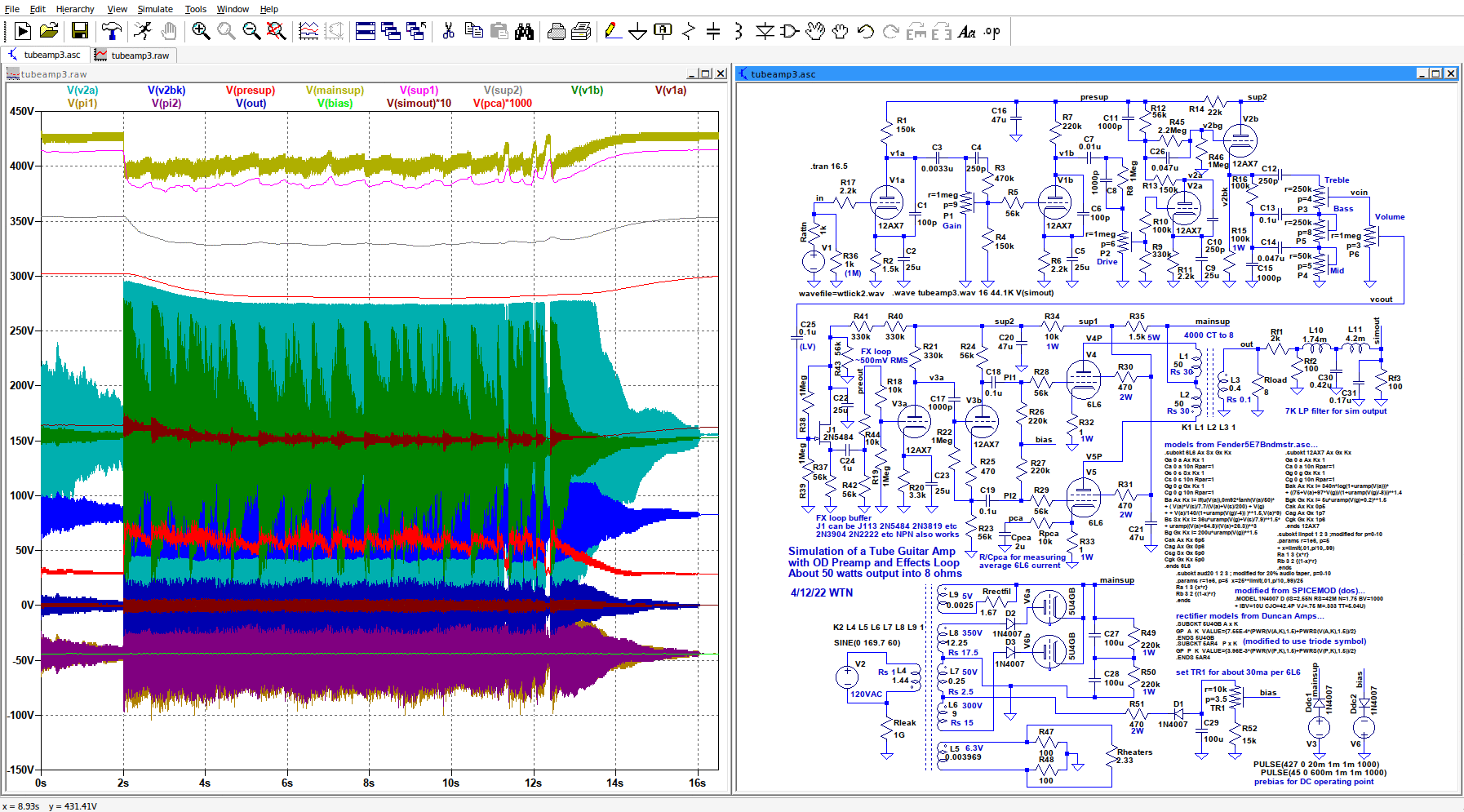
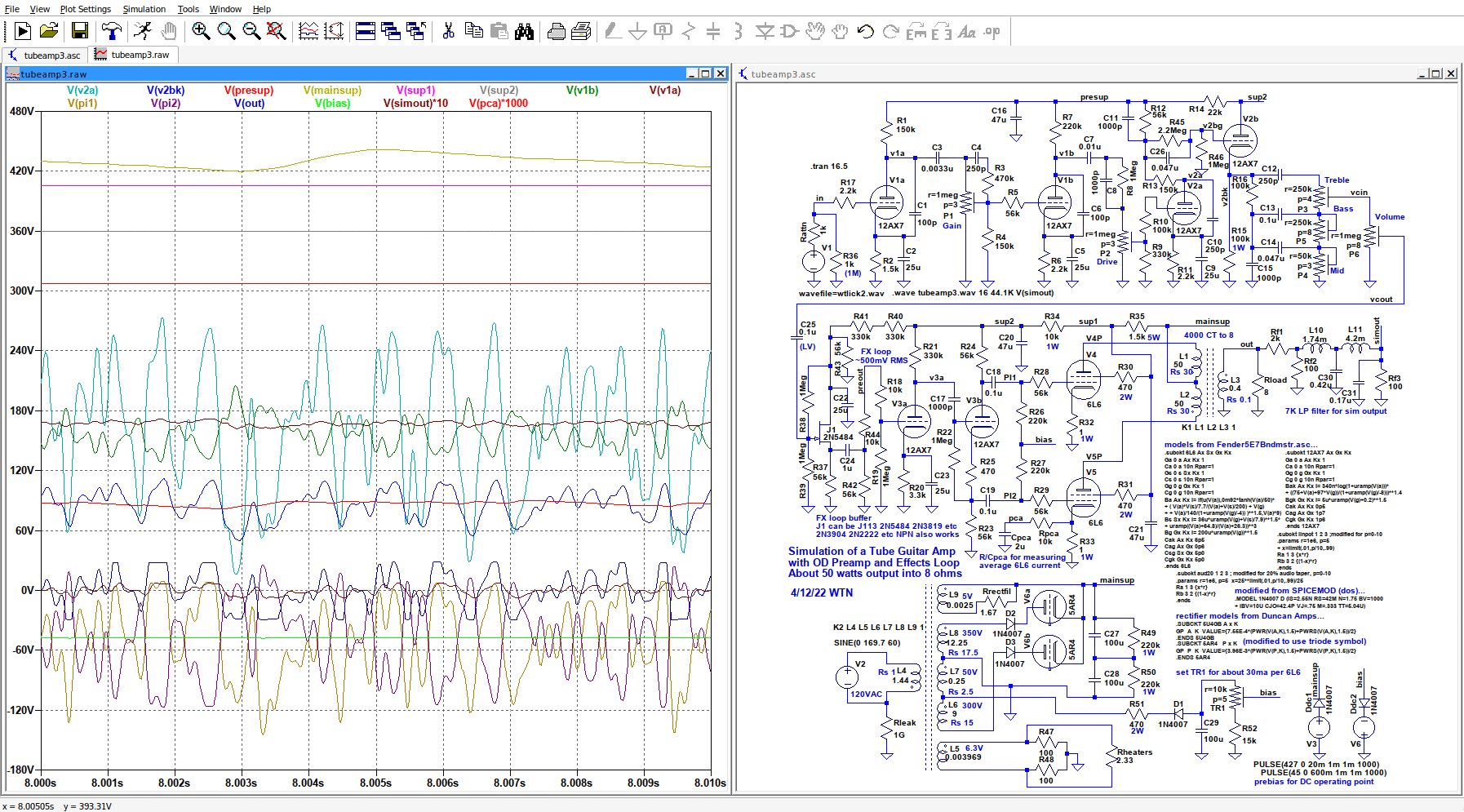
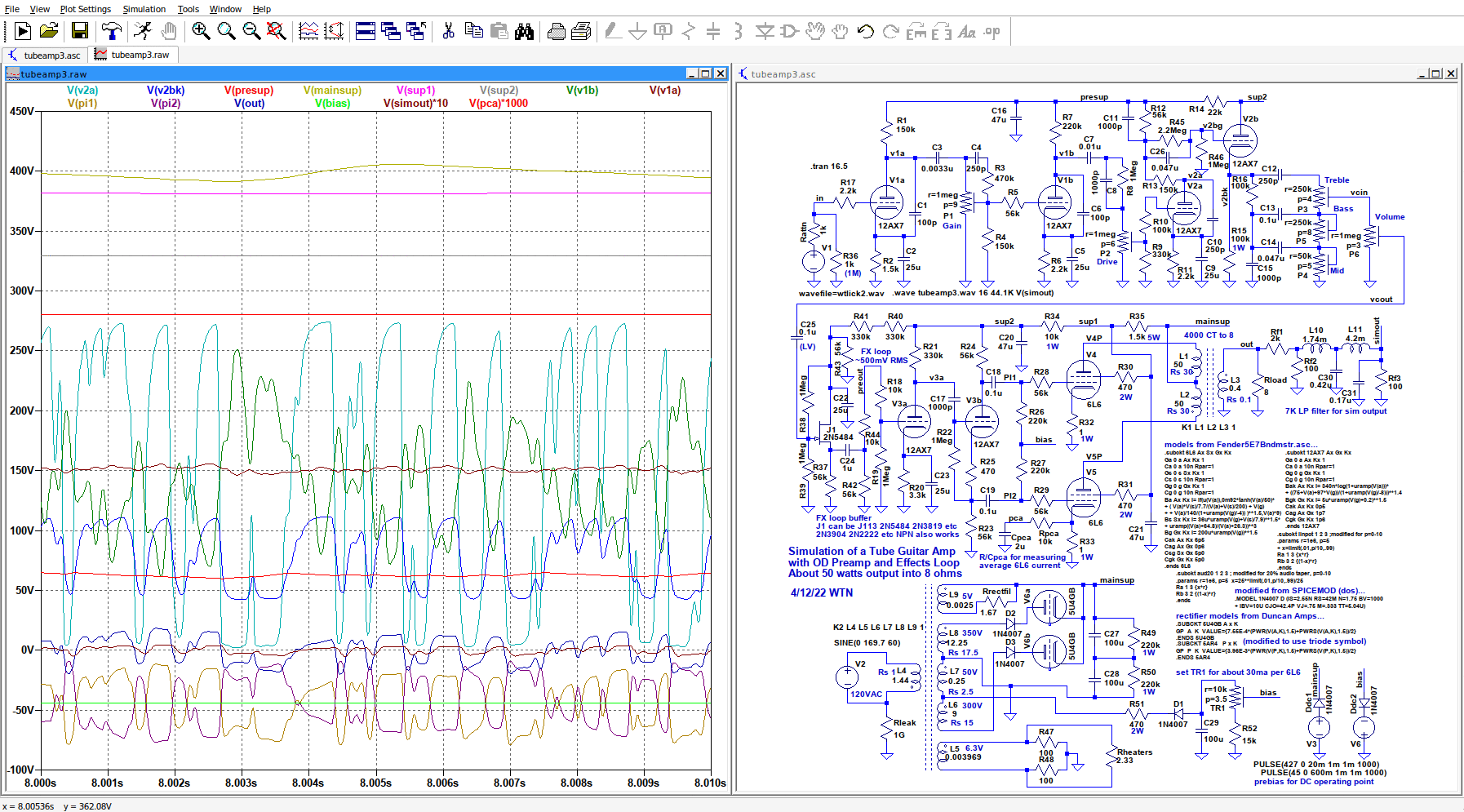
Nice. Here's the low gain simulated output,
and the higher
gain simulated output (converted to MP3 files). Not exactly
what the amp would actually sound like but close, at least about
what it would sound like into a dummy load with a simple 7K LP
filter "speaker emulator" output. Here's a zip file containing the
LTspice files and
the original input sound file.
6/20/25 - The 12AX7 model used in the original 50W amp simulation
wasn't accurate, added a better model and made it the default.
There was a math error in the AUD20 potentiometer model causing it
to not go all the way to zero, fixed. Finally the 1N4007 model
conflicted with the model included with later versions of LTspice,
renamed to 1N4007SM. Here is the updated
zip file and the updated
MP3 output file.
Here are some plots of the new simulation... (click image for
bigger)






The old DM 12AX7 model worked fairly well in this simulation...


...however that model didn't work well at all in the 5E3
simulation, which uses 1.5K bias resistors, was hard to get it to
clip on the bottom part. The new 12AX7 model works better, less
rounding on the bottom and simulated output sounds smoother.
A bit about grounding and other shop
horror stories
11/23/24 - I see a lot written about "star grounding" and how it's the magic thing that solves all noise issues etc, but no. It has its place, but is generally only useful for avoiding potential shifts and induced ripple noise with power-consuming circuits. Beyond the the power stages, not so much and in some cases can be very detrimental. I worked on this one amp that took it to the extreme.. the grounds for just about everything all went to a single point. It sucked! Noisy, and unstable and short of totally rewiring was hard to tame. Here's why.
Every signal flow has the signal, and the return current. These
like to be right next to each other, especially at higher
frequencies. Also, the "ground" (cathode side) of a gain stage is
really an inverting input, and to avoid amplifying unwanted
signals needs to be connected to the ground of the signal source.
For example, for the first tube stage, the cathode resistor and
bypass capacitor needs to be connected to the ground of the input
jack, and the cathode resistor and bypass capacitor of the 2nd
stage needs to be connected to the ground side of the gain
control. Once past the 1st and 2nd stages it doesn't matter as
much but in general anything with a control that goes to zero
should be treated that way, so that when the control is down
(guitar volume or gain control) then there is no potential between
the grid and cathode circuits. The grounds should be as parallel
as possible with the signal wires, ideally through the shield (but
be careful not to add too much grid to ground capacitance),
because otherwise any opening between the runs forms a one-turn
transformer secondary coupling any magnetic fields into the gain
stage. Once wired this way, then where the input jack and gain
control doesn't matter much, generally to the chassis but doesn't
have to be, point is to not amplify any difference between those
two ground points.
Now about that star ground... this amplifier ran the grounds for
the input jacks and cathode circuits all the way across the amp to
the common ground point which also had first stage filter caps and
all sorts of nasty stuff connected to the same point. So instead
of the return current of the input jack going a few inches to the
first stage, it has to travel about 3 feet with lots of
opportunity to pick up noise along the way (remember the ground of
a gain stage is actually another input). No matter how well bonded
the star ground is, at high gains even a few microvolts of ground
potential difference can produce a noticeable hum and a millivolt
difference is a loud buzz. However when stages are properly
grounded to their signal sources they are much more tolerant of
ground differences between the stages, only noticeable when the
gain is cranked with no ground noise at all at minimum gain.
The way I do my tube amp grounds is to run the negatives of the
first two filter caps to the center tap of the power transformer,
attached to a ground lug to the chassis (so that the buzz-rich
filter cap return noise runs straight back to the power
transformer and not through the chassis). The cathodes of the
power tubes should be grounded somewhere near this point - a lot
of the time I don't like relying on single screw-connected grounds
so often will have another ground lug and run a wire between the
transformer/cap and output ground lugs. Where the rest of the
stuff grounds to doesn't matter that much so long as it grounds
(eventually) to the chassis and not the power grounds, and later
stage filter caps are grounded near the stages that they feed -
loops in the power supply can also pick up noise so helps to run
the filter cap hots and grounds together.
I like hard-grounding the input jack (and other jacks) to the
chassis so if there's a fault it doesn't go through the wiring. A
popular preamp grounding method is to run a length of buswire from
the input jacks to the backs of all the controls and ground stuff
to that, however that makes it harder to replace controls and
control backs aren't exactly securely grounded and do become
loose. A better way is to add a few ground lugs (at least two or
three) and run a length of buswire between the lugs and also to
the input jacks. Some internet "wisdom" says multiple grounds
cause ground loops and everything must be grounded separately...
but that's only true if there is current running through the
ground loop, and stages aren't properly grounded to their sources.
Otherwise multiple grounds increase reliability and if there is a
larger loop, it actually serves to absorb hum and RFI in the
vicinity - but stages have to be individually properly grounded or
the current through the loop can become audible.
So.. star grounds - good for power stuff, good for making sure a
group of systems are all running at the same ground potential. But
don't route low level signal returns through the star ground.
Also on this same amplifier, the small-value resistors usually
found in series with the power tube grids were mounted on the
board instead, and it did not like the JJ tubes I installed, had a
totally wacked output waveform. Adding 1.5K resistors in series
with the grids at the sockets solved the problem (didn't bother
removing the existing 1.5K resistors). Also had to add extra 680
ohm grid resistors to a couple of the preamp tubes to keep them
stable, likely to counteract the effect of the shielded wiring -
high gain tube stages don't like too much capacitance connected
directly to the grid.
Here's another one I ran into just last week... had one of those
newish (2010) tube amps (a Blackstar HT 60) chock full of solid
state stuff in for repair, in addition the usual issues - worn out
noisy tubes bad connectors etc - after awhile it would start
popping and crackling, and the output waveform didn't look all
that great but these days it's hard to tell if that's intentional.
Otherwise the amp sounded great with a really nice overdrive
channel, definitely worth saving. It had an oddball phase
inverter, a pair of mosfets driving a 12AU7 tube state. A couple
of resistors were visibly overheated with the color code markings
discolored so found the schematic to verify the values (22K 2W)
and replaced them. Better but was immediately obvious they were
running too hot, one especially (from the voltage readings it was
dissipating about 4 watts, no wonder it was complaining). Looking
at the schematic I noticed they were coupling the mosfets to the
12AU7 grids through a 1uF 450V electrolytic capacitor... sure
enough there was about 1V on one grid and 10V (!!) on the other.
Replaced the electrolytic caps with 0.2uF 630V film caps (2 0.1uF
in parallel), that fixed it, the resistors only dissipate about a
watt each. Still a bit on the hot side but not a problem. Going to
a lower value for the coupling capacitors was not a problem as
they're feeding a ~500K impedance putting the -6db point at about
1.6hz. So yay for having a schematic available, making it a fairly
easy fix. The sad part though is likely every one of those amps
will eventually fail - don't use electrolytic coupling caps for
tube stages.
6/4/25 - The 5E3 Deluxe Kit I
ordered from Weber Speakers has arrived!
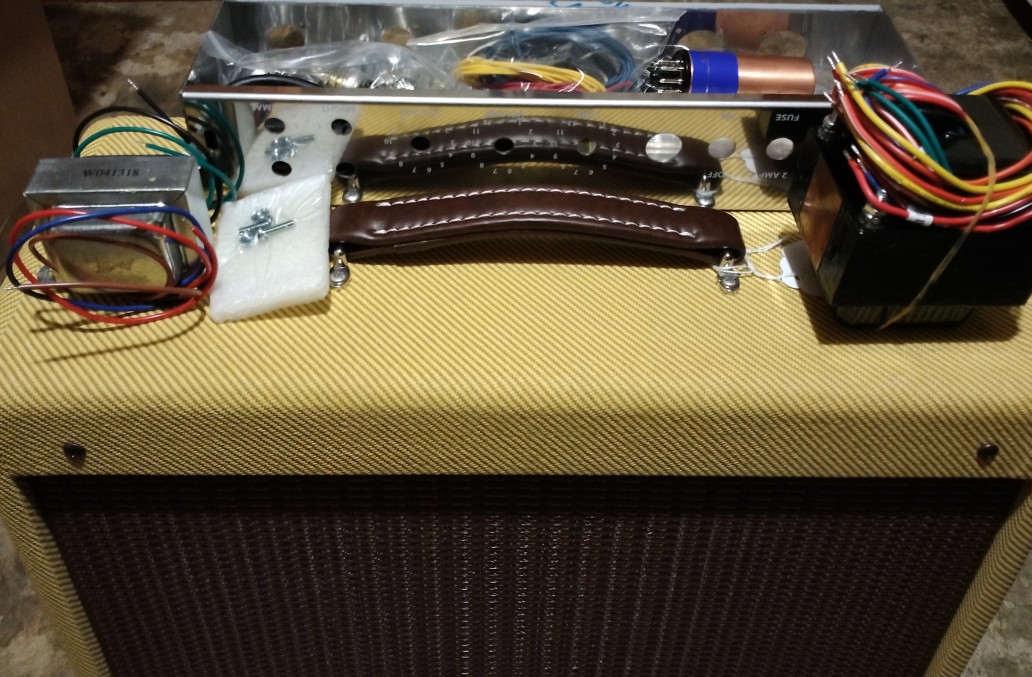
This kit is for experienced builders, it does not come with
instructions beyond the schematic and layout linked from the web
site. It's cheaper than some other kits as it does not include
tubes (except for a Weber Copper Cap rectifier) and the
transformers and other electronic parts are sourced overseas but
that's OK I'm cheap too. I'll probably replace the filter caps
with 22/500 FT caps but other than that as long as it works I
don't care where the parts came from. The cabinet and chassis are
top-notch made in USA with a Weber alnico speaker already
installed, that's what really matters. It took awhile to get the
kit (over 3 weeks), like they made it just for me! Oh and it comes
with a cuzy... [rest of this post and the next deleted, was a good
start but got better once I better understood the circuit]
6/11/25 - It's together!

Construction went well, everything needed was included but I
added a few extra things I wanted - green wire for the filaments
(the kit included lots of blue but nah gotta have green), 3/8"
lockwashers to go under the jacks and controls, a couple of solder
lugs, an 8/32 nut and a lockwasher to avoid having to solder to
the chassis, and some things not part of the original design -
470/2W screen grid resistors (habit), an extra 0.1uF cap and 250KA
control for a master volume, two 330K bleeder resistors, two
1N4007 diodes in series with the rectifier tube plates to avoid
sparking when using a real rectifier tube, and a 1000pF mica cap
to link the channels when nothing is plugged into the bright
channel #1 jack (a simple wire link didn't work out). I did use my
own 22/500 F&T filter caps and a Sprague 25/50 bypass cap
across the 250/5W cathode resistor, and lost one of the 1.5K
resistors for the 6V6 sockets so used my CC's, otherwise used all
the supplied parts. The resistor legs weren't long enough to span
the full width of the fiberboard but that wasn't an issue, the
affected ones were bypassed by capacitors which did fit so just
soldered the resistors to the capacitors first. Most of the
smaller resistors were 1% type and kind of hard to read, used a
meter to make sure I had the right values. It took about one long
day to assemble the kit and get it working, not counting the
tweaks I made after assembly.
Here's a schematic of the modified 5E3 circuit [updated to include the gain reduction mod]...

Here are some pictures of the internals...



The hole between V1 and V2 is where my failed gain boost switch
was.. this circuit doesn't need any boosting.
I ran the transformer center taps directly to the fiberboard to
ensure no supply ripple current flows through the chassis. Ran a
wire across all the pots and grounded to the brass plate and
chassis to ensure loose backs don't cause issues. Actually didn't
really need the brass plate, other than soldering a strap to the
chassis didn't solder anything else to it.. but it looks cool.
Instead I just soldered the grounds to the (strapped) pot backs
and soldered the V1 cathode R/C ground directly to the input
jacks. As much as possible kept the grid and cathode circuits
parallel to each other. The amp is very quiet.
I've worked on 5E3's in the shop, but this is the first time I've
really gotten down and dirty with the circuit. And dirty it is! I
was surprised at how much gain it has, and the backwards-wired
volume controls... well that just ain't right but it's part of
what gives this circuit its character. It's the opposite of
compensated gains like I'm used to - it increases lows to the
subsonic range as the volumes are increased. When I first put it
together with a simple wire channel link it was a disaster, if the
volumes were over about 5 string movement would overload it making
it cut out. The 1000pF link cap solved that, but it's still
unbridled, anything over 2 to 3 is in the breakup range. I like
it!
But I'm tempted to add a gain reduction switch... getting a clean
tone is somewhat difficult, can't get the volumes more than a
notch before it starts to distort. One way to do that is switch a
resistor from V2A grid to ground, but that would also affect the
tone control response. Another way would be use a double-pole
switch to switch in a pair of resistors from the control wipers to
ground.. hmm... a DPDT center-off switch could do both... Yes! The
switch centers are grounded, the side towards the back connects a
100K to V2A grid, the other side separately connects a pair of 39K
resistors to the volume control wipers. Thus center is stock,
pushed in is attenuated, pulled out is loaded. The 39K load
position decreases the total gain by about 8db, keeps the bass
response from going subsonic at higher settings, and helps smooth
out the control taper. The 100K attenuation position doesn't drop
the total gain that much when the volumes are all the way up, but
greatly smooths out the control tapers, have to get to around 6 to
start getting breakup. The tone control still works fine.
This picture shows both the master volume mod and the gain
reduction mod...

I think I am close to 5E3 perfection, the beast has been tamed
yet it's all still there when I want it.
6/17/25 - Ran into a semi-minor issue... was getting a pop when
plugging into the amp, indicating there was some DC coming out of
the inputs. Checked it with a meter, sure enough with an open jack
cord was reading about 300mV out of the normal input and over
500mV out of the bright input. Changing V1 had no effect. While
not much it's enough to cause pedal switches to pop and other odd
effects. The cause is apparently the fiberboard - in high humidity
environments (like my basement) it absorbs moisture and becomes
slightly conductive. Verified that by directly probing the
fiberboard in the vicinity of the B+ eyelets... yep it's slightly
electrified. Not enough to cause operational issues but enough to
cause switching pops. Compounding the problem was the switch
contact on the normal #1 input jack wasn't making contact,
probably should have replaced them with Switchcraft 12A jacks but
for now just cleaned and tweaked them.
I've seen the leakage issue many times with fiberboard-based
amps, and the solution here is the same as always, get those
sensitive 68K input resistors off the fiberboard and solder them
directly to the jacks. The front end wiring now looks like this...

This completely solved the issue, input offset is now less than
1mV and no pops at all.
Normally fiberboard leakage isn't much of an issue, but it has
been very humid here in my basement lately, up to 90% at times.
After the amp had been on for awhile, driving out moisture, the
stray voltage into the nearest (now empty) eyelet had dropped to
only a couple hundred millivolts. My meter has an input impedance
of about 20meg so that corresponds to about 10mV in the usual 1meg
circuit, far less than I measured earlier so the issue appears to
be self-correcting. However, I prefer that my pedal switches not
pop when I first turn on the amp in a humid environment.
6/18/25 - Playing around with my pedalboard...

From right to left that's a TC Electronic polytune tuner, a Mooer
Ninety Orange phase shifter, my Purple Cow overdrive, and a Mooer
Echolizer delay. The amp volumes are cranked pretty hot and the
gain reduction switch is in the stock position, so the echos
distort together. The master volume is quite low. Here's what it sounded like.
That was recorded with a DR40 inside the cabinet, post processing
was just adding a bit of bass and reverb and normalizing the
level.
I like this amp!
6/21/25 - I took some measurements and scope plots from the amp.
With 121V AC line voltage, at idle B+A is 369V, B+B is 319V and
B+C is 248V. That's 0.53 watts on the 4.7K 2W resistor. 6V6
cathodes are 19.2V, V1A and V1B plates are 170V, V1 cathodes are
1.3V, V2A plate is 166V, V2A cathode is 1.25V, V2B plate is 202V
and V2B cathode is 45.4V. Output power is 9.9 watts into 8 ohms
and 13.8 watts into 16 ohms, at the onset of clipping. At clipping
into 8 ohms, B+A is 357V, B+B is 291V (0.93W on the 4.7K) and B+C
is 227V. With heavy clipping into 8 ohms, B+A is 343V, B+B is 271V
(1.1W on the 4.7K) and B+C is 213V.
The following scope plots are rough, taken with my phone with
glare which I gamma'd out, ignore odd waveform tilting.
Output into 8 ohms...




Output into 16 ohms...



Output using the master volume...



Scoping the output of V2A at the master volume hot terminal...





6/23/25 - The frequency distortion at the top of the waveform in
the last two plots appears to be caused the response of my scope
probe in the x10 position, it does not appear in the plots taken
from the amplifier output.
6/25/25 - Voltage readings with different preamp tubes...
Line = 113.7VAC Philips JJ V1=JJ V2=EH
----------------------------------------------------------------------- B+ "A" | 341V | 341V | 341V |
B+ "B" | 296V (9.57ma) | 295V (9.79ma) | 295V (9.79ma) |
B+ "C" | 231V (2.95ma) | 225V (3.18ma) | 226V (3.14ma) |
6V6 cathodes | 18.33V (73.3ma) | 18.30V (73.2ma) | 18.32V (73.3ma) |
V1A plate | 161.2V | 149.1V | 149.4V |
V1B plate | 160.4V | 145.5V | 150.2V |
V1 cathodes | 1.158V (1.41ma) | 1.292V (1.58ma) | 1.267V (1.55ma) |
V2A plate | 156.8V | 149.1V | 147.4V |
V2A cathode | 1.126V (0.75ma) | 1.154V (0.77ma) | 1.196V (0.80ma) |
V2B plate | 188.5V | 179.5V | 182.2V |
V2B cathode | 42.9V (0.75ma) | 46.1V (0.80ma) | 44.8V (0.78ma) |
-----------------------------------------------------------------------
Measurements are approximate and depend on resistor tolerances,
line voltage fluctuations, meter accuracy and loading, etc. The JJ
in the last test was a different sample. As can be seen by this
chart, different brand tubes produce somewhat different readings,
even the two sections in the same tube can differ - V1A and V1B
plate voltages should be nearly equal.
Component value tweaks
7/12/25 - Last weekend I took the amp to an outdoor jam and although it sounded ok and got the job done, it was struggling to keep up with the drums and bass and the other guitar. 9.9 watts at clip then going lopsided doesn't really cut it with a loud band. First thing is keep it from going lopsided so badly, basically replace the 1.5K 6V6 grid resistors with something much bigger. Usually I use 56K for this situation but didn't have any handy, and simulation suggested that the bottom (cathode side) grid resistor should be a bit bigger than the top (plate side) resistor to balance out the clipping, so used 33K on the top (V3) and 47K on the bottom (V4). While at it also reduced the 1.5K in the phase splitter to 1K to give it more headroom, and reduced the 1.5K cathode resistor in the V2A 2nd gain stage to 1.2K to drive that stage a bit harder and even out the initial clipping symmetry and help keep it square longer before it does the asymmetric thing.
These simple changes made a fairly significant difference. Before
it was struggling to get 9.9 watts and clipping on the bottom side
first, now it gets a nice 10.125 watts at clip hitting both sides
of the wave at the same time. It still clips a bit more on the
bottom side when pushed but it's much improved over the original
circuit, squaring both sides of the waveform rather than the
bottom side stealing power from the top side until it gets way
into clipping. The added power now comes immediately which should
improve its perceived loudness.
This is with the master all the way up at various levels of
clipping...




Backing off the master volume a bit keeps the clipping more even,
maximizing output power...


Preamp distortion is mostly like it was, maybe a bit more rounded
on the bottom side...


[note - I had the output transformer wired backwards so flip the
phase of all scope plots taken from the speaker output]
This should do, will find out on the next jam.
Here are the new measurements...
Idle measurements... line=117.8VAC
B+ "A" 359V
B+ "B" 309V
B+ "C" 237V
6V6 cathodes 19.4V
V1A plate 164.7V
V1B plate 163.3V
V1 cathodes 1.215V
V2A plate 153.2V
V2A cathode 1.072V
V2B plate 184.8V
V2B cathode 53.2V
Dynamic measurements... 8 ohms, MV all the way up, line=119.8VAC
Idle At clip Heavy clip
B+ "A" 366V 357V 341V
B+ "B" 315V 290V 268V
B+ "C" 241V 225V 208V
6V6K 19.8V 22.5V 26.7V
OutPwr --- 10.125W 16.3W (approx)
Derived measurements... (OT resistance 135 ohms per leg)
4.7K I 10.85ma 14.26ma 15.53ma ("A" - "B") / 4700
4.7K D 0.553W 0.955W 1.134W ("A" - "B") ^2 / 4700
22K I 3.36ma 2.95ma 2.73ma ("B" - "C") / 22000
250 D 1.568W 2.025W 2.852W 6V6K ^2 / 250
6V6 K I 39.6ma 45ma 53.4ma (6V6K / 250) / 2
6V6 SG I 3.745ma 5.655ma 6.4ma (4.7K_I - 22K_I) / 2
6V6 P I 35.855ma 39.345ma 47ma 6V6_K_I - 6V6_SG_I
6V6 SGK V 293.44V 264.84V 238.29V B+B - 6V6K - (6V6_SG_I * 470)
6V6 PK V 341.36V 329.19V 307.09V B+A - 6V6K - (6V6_P_I * 135)
6V6 SG D 1.1W 1.5W 1.53W 6V6_SG_I * 6V6_SGK_V
6V6 P+L D 12.24W 12.95W 14.43W 6V6_P_I * 6V6_PK_V (inc. load)
6V6 P D 12.24W 7.89W 6.28W 6V6_P+L_D - (OutPwr / 2)
These are approximate calculations and do not take into account
component tolerances, tube imbalance, transformer losses, meter
inaccuracies etc. At first I was calculating rather high plate
dissipations at and beyond clip until I realized that the number
also included the power delivered to the load, after subtracting
that it looks like plate dissipation is the highest at idle. Not
sure if it's totally right but the math seems valid, basically
calculating plate input power minus output power, whatever is left
is the plate dissipation. The heavy clip figure is suspect since
the meter I used is not true-RMS, the voltage reading it gives for
a near square wave is probably not that accurate.
I considered possibly adding a rectifier bypass switch to
increase the power output, but after simulating and calculating to
make that safe(ish) would require increasing the 6V6 cathode
resistor to about 330 ohms and inserting another 330 ohms in
series with the diode supply, just to get it to about 15 watts at
clip. Problem is the increased cathode resistor makes it bias too
cold in the normal rectifier position, would have to use a double
pole switch to avoid that. Maybe but it's already running near the
14 watts max 6V6 plate dissipation so have to be really careful.
Something like that would be better applied to a fixed bias output
section so the idle current can be controlled.
A simpler solution for increasing output power is find a
better-matching output transformer. With the W041318 transformer
supplied with the kit I get more power into 16 ohms (around 14
watts) than into 8 ohms (around 10 watts). Seems that a 6600 ohm
primary is too low, many of the 5E3 replacement transformers are
in the 8000 to 8500 ohm range. A cheap alternative is the 8000 ohm
to 8 ohm P-TGO-002 from Antique Electronics Supply, only $30 plus
shipping. The Hammond P-T1751M looks nice, 8000 ohm primary and
4/8/16 ohm secondary [$54 plus shipping].
8/17/25 - Installed the P-T1751M transformer, that boosted the
output power at clip into 8 ohms to over 12 watts, peak power is
about 18 watts with the master backed off a bit. Not sure (my ears
have been funny lately) but it seems to have a bit more highs now.
Note that the phase of the P-T1751M transformer is the opposite
from the supplied W041318 transformer and most other (but not all)
transformers with brown/red/blue primaries, so for the same
phasing the blue and brown wires need to be reversed. Not sure
what the correct phasing even is for the 5E3 circuit - with no
negative feedback it doesn't matter unless paring with another
5E3. I went by the Weber layout guide which had the blue connected
to V3, so used brown on V3 with the 1751M to keep the same phase.
Then discovered the Weber schematic shows the opposite phase as
the layout so need more research to see which is correct.
Looking at the various kits there seems to be a preference for
brown on V3 with normally-phased transformers so I think mine is
actually wired backwards. The P-TGO-002 transformer is
specifically made as a 5E3 drop-in replacement, and it's phased
with the dots on primary green and secondary black, and the
original 5E3 schematic shows green on V3. So with the 1751M that
would be blue on V3 so yeah it's backwards from the original
circuit - reversed the wires (again). With a single amplifier it
really doesn't matter and it's still basically 50/50 chance of
phasing correctly with another random amp, but at least if I pair
it with another 5E3 it's more likely to match. Maybe.
Another thing I learned... Amplified Parts and Antique Electronic Supply
are basically the same company - same parts and part numbers, same
prices, same address, both are the public version of CE Distribution.
8/21/25 - After examining a few more 5E3 amp kits and builds
there seemed to be a preference for brown on V3, which would be
blue on V3 using a backwards-phased Hammond transformer, but
really there is only one way to settle the issue - do a negative
feedback mod! With negative feedback applied to the cathode of V2A
in the 5E3 circuit there can be only one correct connection, which
as it turns out is brown on V3 with a transformer phased with dots
on brown and black, the consensus for most of the kits and the way
I currently have it wired. But as always when replacing an output
transformer always fire it up at first with the negative feedback
disconnected to make sure that connecting the loop decreases the
gain.
For my negative feedback mod I used the existing DPDT center off
switch I already had in place and modified the wiring so that the
100K post control load remained unchanged (no feedback, this is
the setting I use the most), the center position is the stock
front end with negative feedback, and the far position, previously
the 39K preamp loads, is now stock. This way I can directly
compare the effect of the negative feedback without switching any
other circuit elements. I never used the 39K load position anyway,
was intended to reduce the gain and avoid blocking distortion but
the 100K post control load does that better.
The gain switch is now wired like this...
O--O---. stock
ground-------------------O--O | stock with negative feedback
V2A grid---------100K----O O | post-control loading (no NFB)
(control outs) |x |
V2A cathode--------+22uF----*---' For negative feedback also on the loading
(and cathode R) | position break the connection marked "x"
speaker-------------39K-----'
The 22uF is the same part that was across the V2A cathode
resistor, the only added part is the 39K NF resistor. When the
switch is in the 100K post control load position it grounds the
22uF cap and also grounds the negative feedback signal, so the amp
operates without negative feedback, with only the 100K resistor
loading the output of the control network. Which doesn't reduce
the available gain all that much, mainly just smooths out the
control taper to make it easier to get cleaner tones. When the
switch is in the center off position then the front end is stock
but negative feedback is applied through the 22uF capacitor. The
stock position grounds the cap removing the negative feedback
signal, restoring the stock preamp circuit.
Did some more testing in the shop and found that the NOS tube I
had in V2 was getting flaky, although it was working it was
fooling me with its waveforms, changing the V2A cathode resistor
to 1.2K was a tweak in response to a bad tube! Replaced the old
12AX7's with JJ ECC83S and changed the cathode resistor back to
1.5K, now the plots look normal again. I did verify with a
clipped-on control pot that lowering the cathode resistance below
1.5K made the clipping response worse, so 1.5K it is. But sticking
with the 1K cathode resistor value for the phase inverter.
. . . . . . . . . .
At some point I probably should clean up this section, a lot of
the above no longer applies to this amp - the 39K first stage load
mod is no longer present, was an attempt to solve the "farting
out" problem, which it sort of did but other methods ended up
working better in practice and I found myself never using the 39K
switch position, plus those (unused) resistors hanging in the air
over the fiberboard were starting to bug me, so when the negative
feedback mod came along they had to go. Of all the mods I've made,
the ones I like the best are coupling the channels using a 1000pF
capacitor, the master volume, the 100K post-control load mod for
better control taper and blending, and increasing the values of
the 6V6 grid stop resistors to keep the phase inverter from
crapping out. For cleaner tones and stage work the negative
feedback mod might become a new favorite - actually I've never
heard the amp sound that clean. I'm using a fairly high amount of
feedback (39K) and it drops the gain considerably, making the
otherwise stock preamp setup quite usable (the stock preamp clips
if the controls are much over about 2 making it hard to do
anything clean). It also noticeably affects the preamp clipping
characteristics when using the master volume, as the V2A clip
stage is within the negative feedback loop.
Here is an updated schematic showing the changes I have made so
far...

Voltage readings with AC line = 122.7V (a tad high) with JJ 12AX7
(ECC83S) and EH 6V6 tubes...
Idle 13.03W 15.58W 16.86W 21.06W
------ ------ ------ ------ ------
main supply 375V 366V 363V 359V 352V
SG supply 322V 295V 292V 288V 277V
"C" supply 242V 227V 227V 223V 216V
6V6 cathodes 20.4V 23.3V 24.4V 25.1V 27.1V
V1A plate 156.6V
V1B plate 158.8V
V1 cathodes 1.413V (preamp voltages not
V2A plate 154.6V measured under load)
V2A cathode 1.367V
V2B plate 186.1V
V2B cathode 57.7V
The 13.03W figures are for just slightly into clip into 8.4 ohms,
the estimated resistance of my dummy load and connecting cable.
The remaining measurements are for various degrees of clipping up
to almost square-wave. Power figures are estimates based on the
numbers my non-RMS meter gave me, which are probably
super-accurate but should be in the ballpark.
Derived measurements... (approximate, component tolerance and
load sharing are not considered)
Idle 13.03W 15.58W 16.86W 21.06W
------ ------ ------ ------ ------
4.7K 2W diss. 0.60W 1.07W 1.07W 1.07W 1.20W
250 5W diss. 1.66W 2.17W 2.38W 2.52W 2.94W
Total 6V6 curr. 81.6ma 92.0ma 97.6ma 100.4ma 108.4ma
Preamp current 3.64ma 3.09ma 2.95ma 2.95ma 2.77ma
6V6 SG current 3.82ma 6.01ma 6.08ma 6.08ma 6.59ma (per tube)
6V6 plate curr. 37.0ma 40.6ma 42.8ma 44.1ma 54.2ma (per tube)
6V6 SG diss. 1.223W 1.756W 1.758W 1.734W 1.805W (per tube)
6V6 plate diss. 13.12W 7.399W 6.702W 6.295W 7.080W (per tube)
The formula I used to calculate plate dissipation is...
((main_supply_V - 6V6_cathode_V - (6V6_plate_current /
150)) * 6V6_plate_current) - (output_power / 2)
...the 150 figure is the output transformer leg resistance.
Basically it calculates the plate input power then subtracts half
of the output power to estimate the actual plate dissipation.
Here are some new pictures of the internals...

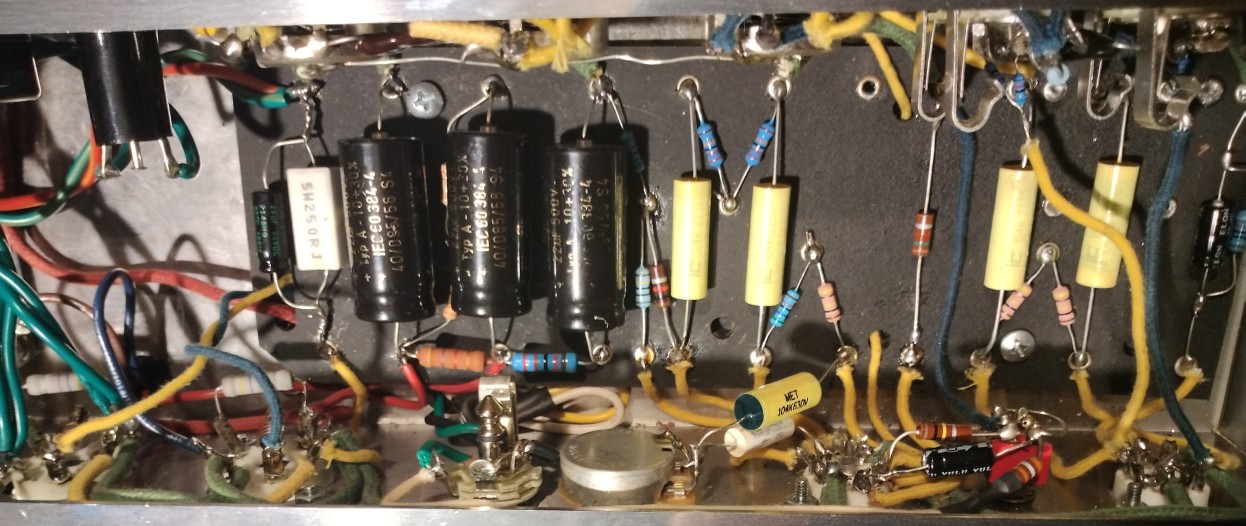
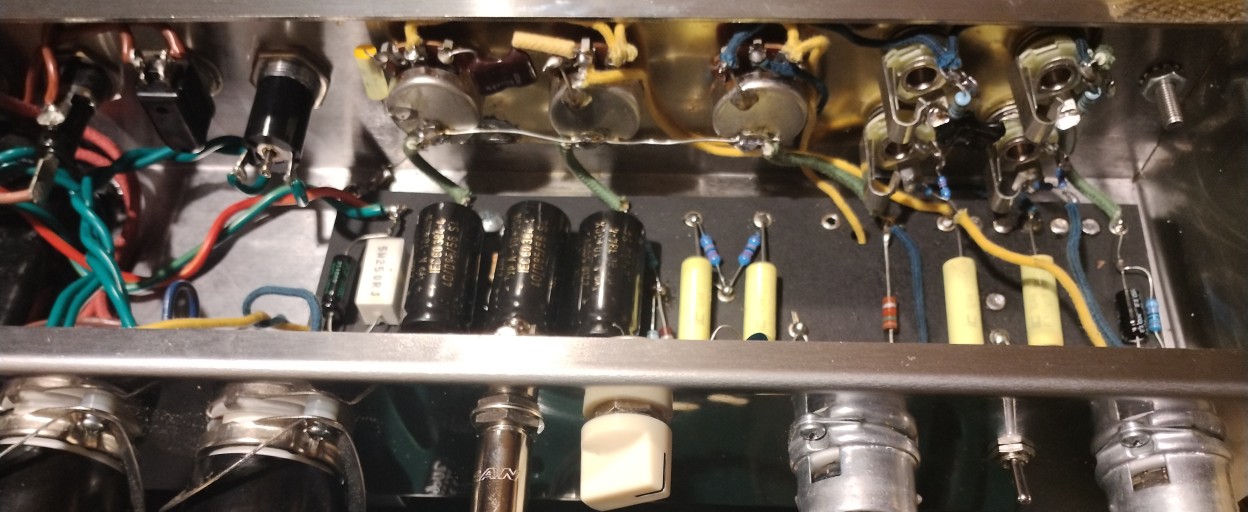
The 68K jack resistors are in the air rather than on the
fiberboard is to prevent leakage from the nearby high voltage
eyelets, especially in humid environments, putting a fraction of a
volt on the input lines depending on the impedance of whatever
their hooked to. While that's not enough to seriously affect
performance, it caused pops when plugging stuff in and out and
operating pedal footswitches.
I didn't twist the heater wiring, instead cut each wire to length
then tightly fitted them under the lip of the chassis. This seems
to work fine, the amp is very quiet. For grounding I used a wire
on the back of the controls that's also grounded to the input
jacks, with the supply side of the wire grounded to the chassis.
Probably overkill but I hate it when nuts get loose and bad things
happen. The circuit grounds ground to the control ground wire, and
the V1 cathode R/C grounds directly to the input jacks. The
transformer center-tap grounds to the first filter cap ground on
the fiberboard (actually the 6V6 cathode resistor but same effect)
to make sure no supply ripple current passes through the chassis
or other ground networks. The only place I trusted a control
ground was the master volume but it's a nice CTS control placed
underneath the amp and unlikely to come loose. The reason it's
underneath is because I wanted to preserve the stock look but also
so that when using as backline for jams I wanted to be able to set
the maximum volume in a way that's less likely to be messed with
by the jammers... sometimes 15 watts is still too loud.
Scope plots... These are with JJ ECC83S preamp tubes and EH
6V6's.
Output with the stock setting (no negative feedback), delivering
~13W, ~15.6W, ~16.9W and ~21.1W...




Output with the negative feedback setting, delivering ~13.9W and
~15.5W...


The at-clip plot is noticeably cleaner and it's more symmetrical
going into clipping. The higher power plots are almost identical
to the non-feedback plots so omitted.
Preamp distortion with the negative feedback setting, 130mV input
into bright #1, normal volume down. Delivering ~7W, ~8W, ~9.1W and
~10.5W as the bright volume set to 3, 4, 8 and 11...




Preamp distortion with the 100K load taper mod setting, 130mV
input into Normal #1. Delivering ~6.3W, ~7.7W, ~9.2W and ~11.6W as
both the normal and bright volumes are set to 3, 5, 8 and 10.5...




Preamp distortion with negative feedback enabled starts off more
symmetrical but flattens out on the bottom sooner with sharper
edges. Distortion without negative feedback (the waveforms with
the stock setting are similar) is mushier, starts out more rounded
on the top and stays rounded on the bottom longer before
flattening out. Both produce extreme duty cycle shift when pushed
must past grid conduction, an extra grid stop resistor on V2B
could help avoid this but I kind of like it. Plus this design
isn't meant for heavy overdrive anyway, but it is desirable that
it tolerate a certain level of overdrive without crapping out to
make it pedal-friendly.
LTspice Simulation of the modified
5E3 circuit
6/20/25 - To get a better idea of what's going on with this
circuit I entered it into LTspice.. and discovered that the Duncan
12AX7 model I was using barely functioned with this circuit, with
a 1.5K cathode resistor and a 100K load resistor it clipped only
on the top side, clearly not right. That's when I found myself
going down a rabbit hole of trying various tube models.
The one that best matched the voltages I measured in the actual
circuit was a 12AX7 model labeled "NEW MODEL", obtained from https://www.normankoren.com/Audio/Spice_preamp_2.html.
Other models that worked reasonably well are the 12AX7A-mz model
from https://www.diyaudio.com/community/attachments/tubes-ltspice-lib-txt.999666/,
the JD_12AX7 model copied from an
Electronic Design article (was in an image so typed it in
without the comments), and the 12AX7CRV Model Paint example from https://www.dmitrynizh.com/tubeparams_image.htm.
I found two 6V6 models that mostly worked: the Duncan
6V6 model which better matched the bias voltage in the real
circuit (the original has typos, fixed in this sim), and a 6V6GT
model from Ice
Amplifiers that biases a bit higher and has lower screen
grid current when overloaded. [...previous simulations replaced
with improved simulations that better match what I'm seeing on the
scope]
6/23/25 - The 12AX7 models I found tended to be a bit too rounded
on the bottom part of the waveform, the grid diode is too soft. So
I used the Model
Paint program to make my own 12AX7MP model based on a 12AX7
datasheet from Automatica then manually tweaked the advanced
grid parameters until the waveform looked approximately like the
real thing (although that made the resulting grid current at
higher positive grid voltages unrealistic). Still not exact but
closer, and like the other 12AX7 models besides the "NEW MODEL"
the resulting plate voltages are a bit lower than measured in the
actual circuit. The plate resistance seems to be a bit higher, so
in the 5E3 circuit the 12AX7MP model clips on the top first, which
better matches what I normally see with a 100K/1.5K 12AX7 preamp
stage. I got lucky with the mostly symmetrical clipping of the
Philips 12AX7 I have in the amp.
The simulations are approximate. The output transformer is simply
coupled inductors and doesn't model the response of a real output
transformer. Then again I'm of the opinion if you can "hear" the
output transformer it's probably too small. The power supply in
this simulation is just a voltage source in series with a
resistor, the sag is somewhat similar to the real circuit but the
real amp sags a bit more.
Power tube clipping of various degrees, master volume is all the
way up... (click images to make bigger)






Typical nastiness of a single-triode phase inverter - when the
bottom tube grid conducts it messes up the top tube drive. The
effect is somewhat worse in the actual circuit.
Here's the cool thing, backing off of the master still permits
full power output but with much less nastiness...


Preamp distortion...


This looks similar to the waveform of the real thing but I might
have got the grid conduction too hard, the parameter "IGEX" in the
12AX7MP model controls how quickly the grid conducts, I currently
have it at a fairly high value of 15, lower values result in
softer clipping on the bottom part of the waveform.
Here's the same plot with the Koren "NEW MODEL" 12AX7...


It's pretty close but to me it seems like it has a bit too much
rounding on the bottom of the waveform, more noticeable on the
green V2A plate trace. But maybe not... this model more closely
matches the DC values in the real amp. Getting grid conduction
right is tricky, in addition to modelling the forward conduction
characteristics there also seems to be some sort of hysteresis or
memory effect - the onset of conduction is harder than the
release. This is tricky to model with spice and none of these
models take that into effect (a rabbit hole for another day).
Simulated preamp distortion with a guitar signal... (output in 5E3mod_9863.mp3)


Simulated power tube distortion with a guitar signal (output in 5E3mod_5568.mp3)


Here is a zip file containing the 5E3mod
LTspice simulation files.
At first I thought the simulation wasn't capturing the typical
asymmetric clipping of a 5E3/Princeton style output stage, but
that was mainly because I wasn't turning the master volume up
enough to make the 6V6's conduct. It still isn't a perfect
simulation (with the real circuit the bottom side starts squashing
as soon as the top side clips) but the effect is there. The master
volume makes a huge difference in taming the single-triode phase
inverter. Another trick that helps prevent uneven squashing is
increase the size of the 6V6 grid stop resistors, they're 1.5K in
the stock circuit but they can be increased to 56K or even 100K to
avoid excessively loading the phase inverter when the grids start
conducting.
7/4/25 - More simulation stuff...
The previous simulation used 900 ohms in series with the supply
voltage, but the sag still wasn't realistic - to approximate what
I was actually measuring I had to increase the resistance to 2K,
which seems a bit unrealistic. So I made another simulation using
a Duncan 5Y3 tube model and transformer models inferred from
datasheets and actual voltage and resistance readings... I still
had to twiddle the sim using series resistance but now only needed
50 ohms to fairly closely match what I was measuring from the real
circuit.
For the output transformer I found the Weber datasheet for the
W041318 and found it was 6600 ohms CT to 8 (I probably should have
known that) so the henry ratios are (6600/4) 1650/8 so for 100
henry primary legs the secondary needs to be 0.485 henries.
Primary resistances were set to what I measured, 135 ohms for the
blue winding and 139 ohms for the brown. Secondary resistance was
set to 0.3 ohms to sort of match the output power I was getting -
9.9 watts at clip into 8 ohms. For the W025130 power transformer,
with 118.4VAC line I measured 356V per leg, primary resistance
(including fuse and wiring) was 2.8 ohms, one HT leg was 72 ohms
and the other was 76 ohms. The henry ratio is 356/118.4 squared =
~9.04 so for a 10 henry primary each secondary leg needs to be
90.4 henries. For simulation purposes the exact henries doesn't
really matter as with perfect coupling there is no leakage
inductance, only the ratios matter.
From the actual amp with 121.3VAC line (I get a lot of variation
here), at idle "A" is 369V, "B" is 319V and "C" is 248V. At clip,
"A" is 357V, "B" is 291V and "C" is 227V. In heavy clip, "A" is
343V, "B" is 271V and "C" is 213. With the new sim, at idle "A" is
369V, "B" is 320V and "C" is 251V. At clip "A" is 359V, "B" is
301V and "C" is 236V. With heavy clip "A" is 347V, "B" is 281V and
"C" is 216V. It's not exact but it's fairly close to the actual
readings, the main discrepancy is the Duncan 6V6 model doesn't
draw as much screen grid current under overload conditions as
6V6EH tubes in the amp.
Here's the plots with light and heavy clipping...




That's a lot of ripple on the "A" supply. New LTspice asc/plt
files added to the zip file.
Simulations using the tweaked resistor values
7/13/25 - I tweaked some of the resistor values to improve the clipping performance of the output stage. The 6V6 grid resistors were changed from 1.5K to 33K on V3 and 47K on V4, this lessens the load on the phase splitter so that the clipping is more even rather than mostly concentrated on one side. The 1.5K in the phase splitter (V2B) was reduced to 1K for more headroom, and the 1.5K cathode resistor in the 2nd stage (V2A) was reduced to 1.2K to make it clip a bit more on the bottom first before going flatline on the top.
At clipping...




Moderate clipping...




Heavy clipping...




The 6600:8 transformer that came with the kit doesn't seem to be
the optimum match for this amp (I get more power at 16 ohms than
8), considering replacing it with a Hammond P-T1751M 8000CT
to 4/8/16 to get a bit more clean power. After the resistor mods
I'm getting about 10.2 watts at clip, according to the sim the
replacement transformer should give me 13 watts or more at clip...








New LTspice files added to the zip file.
8/17/25 - After installing the 1751M transformer I'm measuring
12.15 watts at clip into 8 ohms (118V line), not quite the 13
watts implied by the simulation but still better than the 10.2
watts from the original transformer.
9/15/25 - The last mod I did to the amp was to repurpose the mod
switch so that instead of applying 39K loads to the 1st stage
outputs it now enables a negative feedback loop using a 39K from
the speaker output to the 1.5K cathode resistor of V2A, through
the 25uF bypass capacitor since that made it easy to switch
between stock and negative feedback by grounding the junction
between the resistor and capacitor. So now the switch selects
between stock, negative feedback and 100K load mod. Reversed the
connections to the output transformer so the negative feedback
would be properly phased.
The negative feedback connection reducing the gain of the output
stage by about 8db, reducing distortion...


The effect is more pronounced with the actual amp but even with
the simulation the output is closer to a sine wave with the
harmonics reduced by about 4db. Also increased the output power to
over 13 watts at clip.
LTspice is useful for studying the circuitry, however none of the
tube models accurately capture the actual observed behavior under
clipping conditions, especially for the preamp tube models.
Actual...


Versus simulation (using the 12AX7CRV model)...


Well I guess it's kind of close I but the real thing is more
rounded when in grid saturation (bottom half of the wave from the
preamp plate but the top half of these plots due to phase
inversion of the output stage), and the models tend to clip more
on the positive/cutoff side of the wave. Adjusting the 1.5K
cathode resistor can compensate for this.
The quest for the perfect tube simulation continues....
9/16/25 - I found a 12AX7 model that works better, actually I
already had it, it's from the document Modeling
on Mondays: Nonlinear SPICE models of Vacuum-Tube Triodes (Part
3). The original model used the simple diode/resistor to
model grid current which doesn't exactly produce realistic
clipping, so put the same parameters into Model
Paint and enabled the advanced grid option, then dialed in
something that resembled the actual waveforms I was observing.
Here are the results...


That's pretty darn close. Still biasing at slightly less current
than observed but not by much. Here are the full plots...


The new 5E3mod_X3.asc file has been added to the zip file.
9/17/25 - The "DM" model parameters matched older 12AX7
datasheets quite well, here's the Model Paint curves with the
Mullard datasheet curves overlaid (matches other old 12AX7 curves
were similar)...
.gif)
...but not so much with the JJ ECC83S curves...
.gif)
So starting with the JD curves I twiddled the dials for a better
match...
.gif)
...and that made almost no difference. Biased at slightly less
current, maybe just a tad closer to the observed waveforms but
only by a tiny bit but it's still not replicating the real thing
which with 1.5K/100K values initially clips slightly more on the
"cold" (higher current) side. It's possible I have an off-spec
tube but at this point might need to rig up a test setup and
derive my own curves. I really don't need a full set of curves,
with a resistor-loaded amplifier for a given supply a given
current drain must result in a plate voltage defined by the
voltage drop across the plate resistor, AKA the load line...
.gif)
Only the measurements in the vicinity of the load line actually
matter as physics doesn't allow anything else, at least
statically, however loading from the following stage changes the
effective plate resistance so the curves should match somewhat
beyond the load line. That's why matching the curves to the JJ
curves didn't do much because in the vicinity of the load line not
much changed.
A simple test circuit that permits measuring the grid vs plate
voltage and current for a few sizes of plate resistors centered
around 100K (say 47K, 68K, 82K, 100K, 120K, 150K and 180K or
really whatever is handy) should provide enough information to
more precisely match the model to reality. A 9V battery connected
to a potentiometer can serve as the variable grid voltage, for
each plate resistor value measure the plate voltage and voltage
across the resistor to derive the current for each grid voltage
step. Also would be a good opportunity to measure actual grid
current versus plate voltage for positive grid values.
Something like this for the test setup...
Supply V (~240V) -----RP-----*------. vary RP around 100K
| |
(+9V for grid current) 1K 1% V plate current
-9V .----------. | | (volts=ma)
| | | *------*
| V Grid cur | __|__ |
_|_ |(volts=ma)| |_____| Vplate
| | | | |
| |<---*----1K----*---------- |
|___| 1% | _____ |
| 10K Vgrid | | |
| pot | 12AX7 | |
_|_ _|_ DUT _|_ _|_
Start with -9V on the control then for each value of RP measure
Vplate and plate current for each value of Vgrid from 0V to say 4V
stepping 0.5V (typical for datasheet curves). Then reverse the 9V
and go back to 100K plate to measure grid current at say 0.5V 1V
1.5V and 2V, noting the plate voltage for each. Seems easy enough
to set up. There are other fancy curve tester designs (such as the
various uTracer designs from www.dos4ever.com
yeah that would be nice to have) but pretty sure that just a few
measurements around the load line will be sufficient to reasonably
recreate the performance of simple 12AX7 RC-coupled amplifiers
with SPICE, especially if the positive grid current can be
accurately measured and modeled.
Terry Newton (wtn90125@yahoo.com)